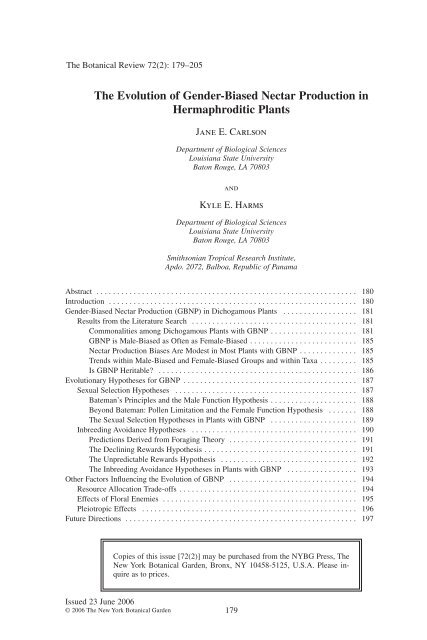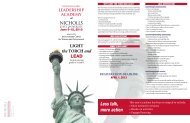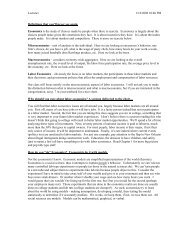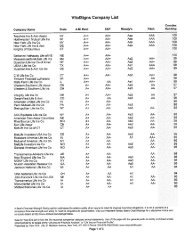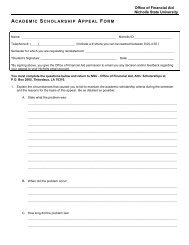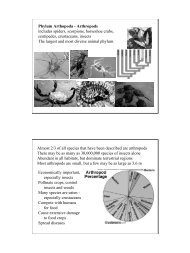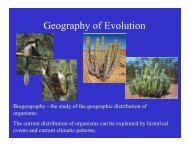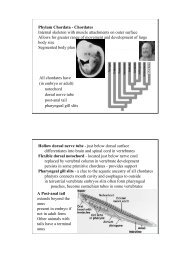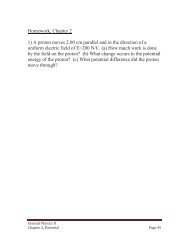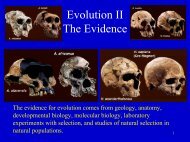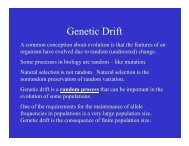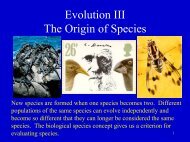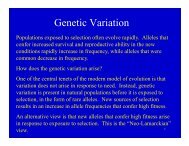The Evolution of Gender-Biased Nectar Production in ... - BioOne
The Evolution of Gender-Biased Nectar Production in ... - BioOne
The Evolution of Gender-Biased Nectar Production in ... - BioOne
Create successful ePaper yourself
Turn your PDF publications into a flip-book with our unique Google optimized e-Paper software.
180 THE BOTANICAL REVIEWTests <strong>of</strong> Hypotheses for GBNP Us<strong>in</strong>g Plants . . . . . . . . . . . . . . . . . . . . . . . . . . . . . . . . . 197Detect<strong>in</strong>g Intrasexual Selection <strong>in</strong> Plants . . . . . . . . . . . . . . . . . . . . . . . . . . . . . . . . . 197Assess<strong>in</strong>g the Costs <strong>of</strong> Inbreed<strong>in</strong>g <strong>in</strong> Plants . . . . . . . . . . . . . . . . . . . . . . . . . . . . . . 198Tests <strong>of</strong> Hypotheses for GBNP Us<strong>in</strong>g Poll<strong>in</strong>ators . . . . . . . . . . . . . . . . . . . . . . . . . . . . . 198Dist<strong>in</strong>guish<strong>in</strong>g between Alternatives Us<strong>in</strong>g Poll<strong>in</strong>ator Forag<strong>in</strong>g Behavior . . . . . . . . 198Conclud<strong>in</strong>g Remarks . . . . . . . . . . . . . . . . . . . . . . . . . . . . . . . . . . . . . . . . . . . . . . . . . . . . . 199Acknowledgments . . . . . . . . . . . . . . . . . . . . . . . . . . . . . . . . . . . . . . . . . . . . . . . . . . . . . . . 199Literature Cited . . . . . . . . . . . . . . . . . . . . . . . . . . . . . . . . . . . . . . . . . . . . . . . . . . . . . . . . . 200Abstract<strong>The</strong> evolution <strong>of</strong> secondary sexual floral traits may be driven by selection throughmale or female reproductive success. Even so, the gender-biased function <strong>of</strong> a floral traitis <strong>of</strong>ten unapparent because secondary sexual traits and primary sexual organs <strong>of</strong> bothgenders co-occur with<strong>in</strong> most bisexual flowers. With<strong>in</strong> dichogamous plants, however,secondary sexual traits may be unambiguously expressed <strong>in</strong> association with the primarysexual organs <strong>of</strong> one gender, mak<strong>in</strong>g these species uniquely suited to studies <strong>of</strong>natural and sexual selection on floral traits. <strong>The</strong> objectives <strong>of</strong> this article are to summarizepatterns <strong>of</strong> gender-biased nectar production and to critically explore theories relevantto its evolution. We list 41 species with gender-biased nectar production and providetwo sets <strong>of</strong> adaptive hypotheses for the trait: sexual selection hypotheses and<strong>in</strong>breed<strong>in</strong>g avoidance hypotheses. We formulate these hypotheses us<strong>in</strong>g sexual selectiontheory <strong>in</strong> plants and the literature that relates poll<strong>in</strong>ator forag<strong>in</strong>g to plant <strong>in</strong>breed<strong>in</strong>g. Wealso consider explanations based on resource trade-<strong>of</strong>fs, enemies, and genetic correlations.Support for the sexual selection and <strong>in</strong>breed<strong>in</strong>g avoidance hypotheses is providedby only a few well-studied species. We outl<strong>in</strong>e a series <strong>of</strong> experiments that should facilitatesort<strong>in</strong>g among hypotheses. Plants with gender-biased nectar production are likelyto provide unique <strong>in</strong>sights <strong>in</strong>to the roles <strong>of</strong> natural and sexual selection <strong>in</strong> the evolution<strong>of</strong> floral traits.Introduction<strong>Gender</strong>-specific traits <strong>in</strong> plants with simultaneously bisexual flowers may appear tobe conf<strong>in</strong>ed to the primary sexual structures <strong>of</strong> the flower. For example, traits <strong>of</strong> thepollen gra<strong>in</strong> are generally unambiguously male-specific <strong>in</strong> function, whereas the nectarproduction rate or the corolla color, both secondary sexual traits, cannot be immediatelyassociated with either male or female floral function. Secondary sexual traits <strong>of</strong> flowerscan, nonetheless, contribute disproportionately to male or female reproductive output.Corolla phenotype and nectar volume, for example, have been shown to serve genderbiasedfunctions <strong>in</strong> a few well-studied species (e.g., Bell, 1985; Stanton et al., 1986;Campbell, 1989; Galen & Stanton, 1989; Melendez-Ackerman & Campbell, 1998).Nonetheless, the co-occurrence <strong>of</strong> both primary and secondary sexual structures with<strong>in</strong>the simultaneously bisexual flower <strong>in</strong>troduces some ambiguity <strong>in</strong>to studies <strong>of</strong> thegender-biased function <strong>of</strong> secondary traits, because most secondary traits are physicallyassociated with both floral genders.Dichogamous plant species—those that temporally separate male function and femalefunction with<strong>in</strong> flowers—may provide a unique means <strong>of</strong> reduc<strong>in</strong>g this ambiguity.In dichogamous species, the expression <strong>of</strong> a secondary sexual trait may vary with sexual
GENDER-BIASED NECTAR PRODUCTION IN HERMAPHRODITIC PLANTS 181phase. Floral nectar production rates, for example, can be higher dur<strong>in</strong>g one <strong>of</strong> the sexualphases, and the result is gender-biased nectar production (GBNP). <strong>The</strong> unequal distribution<strong>of</strong> nectar between male and female phases immediately associates a differentnectar production schedule with each gender and may reflect a true functional bias towardsmale or female fitness. <strong>Gender</strong>-biased nectar production is therefore likely to beparticularly <strong>in</strong>formative about the nature <strong>of</strong> sexual or natural selection on secondarytraits, yet it has been studied <strong>in</strong> only a few isolated cases.In this paper, we show that a diverse group <strong>of</strong> hermaphroditic plants exhibits genderbiasednectar production, and we critically evaluate hypotheses that may expla<strong>in</strong> thenectar production patterns <strong>in</strong> these species. First, we summarize published examples <strong>of</strong>dichogamous species that exhibit nectar production biases, and we describe trends apparentamong these species. <strong>The</strong>n, we explore theories relevant to the trait’s evolution,which correspond to five ma<strong>in</strong> categories: sexual selection, natural selection aga<strong>in</strong>st <strong>in</strong>breed<strong>in</strong>g,resource trade-<strong>of</strong>fs, floral enemy effects, and evolution by correlated traits(pleiotropy). We focus our discussion on sexual selection and <strong>in</strong>breed<strong>in</strong>g avoidance theories,and from these, we extract four ma<strong>in</strong> hypotheses that may expla<strong>in</strong> gender-biasednectar production. We then discuss the rema<strong>in</strong><strong>in</strong>g three topics and f<strong>in</strong>ish with an experimentalframework designed to help researchers discrim<strong>in</strong>ate among the ma<strong>in</strong> hypotheses.<strong>Gender</strong>-<strong>Biased</strong> <strong>Nectar</strong> <strong>Production</strong> (GBNP) <strong>in</strong> Dichogamous PlantsDichogamy is remarkably widespread with<strong>in</strong> the angiosperms (Bert<strong>in</strong> & Newman,1993; Barrett, 2003). With<strong>in</strong> dichogamous species, the number that bias nectar productiontoward the male or female phase is currently unknown. Species that exhibit genderbiasednectar production have <strong>in</strong> fact received little attention, although they are likely toprovide a unique perspective to studies <strong>of</strong> the evolution <strong>of</strong> secondary sexual floral traits.For these reasons, we attempted to compile an exhaustive list <strong>of</strong> hermaphroditic specieswith gender-biased nectar production from the literature. Topics <strong>of</strong> searched literature<strong>in</strong>cluded, but were not limited to, the physiology and biology <strong>of</strong> nectar production, poll<strong>in</strong>atorbehavior at <strong>in</strong>florescences, and sexual selection <strong>in</strong> hermaphroditic plants. Plantspecies were <strong>in</strong>cluded if dichogamy was clearly established, if nectar production rates <strong>in</strong>male-phase and female-phase flowers were consistently different (i.e., one phase was almostalways more reward<strong>in</strong>g), and if all plants <strong>in</strong> the study populations produced onlybisexual flowers (i.e., studies <strong>of</strong> monoecious, dioecious, and gynodioecious plants wereexcluded).results from the literature searchCommonalities among Dichogamous Plants with GBNPOur literature search revealed 41 dichogamous species with male- or female-biasednectar production, represent<strong>in</strong>g 18 families and 22 genera (Table I). Despite wide taxonomicdiversity among species, nearly all share a few key characteristics. Most genera(20 <strong>of</strong> 22) are protandrous (male phase precedes female phase <strong>in</strong> time); the only twoprotogynous (female phase precedes male phase) taxa are Ribes speciosum and Scrophulariaspp. All listed species may have more than one flower open at the same time,although flower counts range from fewer than five (Campanula rotundifolia; Cresswell
Table I.Dichogamous species with gender-biased nectar production.Family and species <strong>Nectar</strong> <strong>Gender</strong> Volume <strong>of</strong> M:F Poll<strong>in</strong>ator Vertical Visit References fcollection bias nectar produced Mass <strong>of</strong> sugar ratio b type c nectar bias etechnique a (L) produced (mg) gradient dMale Female Male FemaleProtandrous species:CampanulaceaeCampanula rotundifolia Stand<strong>in</strong>g F 0 0.01 0 8.25 × 0:0.01 B no Y p Cresswell & Robertson, 199410 −2LamiaceaeLavandula stoechas 12 hour F g 0.047 0.093 2.4 × 2.6 × 1:2.0* B no Y Gonzalez et al., 199510 −3 10 −3BrassicaceaeStreptanthus culteri Unknown F 0 >0 0 >0 0:>0 I ? ? Roll<strong>in</strong>s, 1963Streptanthus car<strong>in</strong>atus Unknown F 0 >0 0 >0 0:>0 I ? ? Roll<strong>in</strong>s, 1963Plantag<strong>in</strong>aceaeDigitalis purpurea 24 hour F less more less more B yes ↑ Y Best & Bierzychudek, 1982OnagraceaeEpilobium angustifolium 12 hour F — — 6.3 × 11.7 × 1:1.9* B yes ↑ Y Pyke, 1978b; Galen &10 −4 10 −4 Plowright, 1985a, 1985b†RanunculaceaeAconitum columbianum 24 hour F h 1.95 2.62 — — 1:1.3* B yes ↑ Y Pyke, 1978bDelph<strong>in</strong>ium virescens Stand<strong>in</strong>g F h 0.3 0.45 — — 1:1.5 B yes ↑ Y Wadd<strong>in</strong>gton, 1981Delph<strong>in</strong>ium barbeyi 24 hour F h 2.4 4.42 — — 1:1.8* B yes ↑ Y Pyke, 1978bDelph<strong>in</strong>ium nelsonii Stand<strong>in</strong>g F — — 0.21 0.43 1:2.0* B/H yes ↑ Y Pyke, 1978b; Cruden et al.,1983†RubiaceaePentagonia macrophylla 24 hour i F 70.7 122.6 — — 1:1.7 H no N McDade, 1986EricaceaeMacleania bullata Lifetime M h 50 25 — — 2.0:1* H no ? Navarro, 2001GesneriaceaeChrysothemis 12 hour M 9.28 6.36 3.05 1.80 1.5:1* H no Y J. Carlson, unpubl.friedrichsthalianaMoussonia deppeans 24 hour M 1.76 1.18 — — 1.5:1* H no N q Lara & Ornelas, 2001182 THE BOTANICAL REVIEW
CampanulaceaeLobelia laxiflora Lifetime M 15.2 11.77 — — 1.3:1* H ? ? Fe<strong>in</strong>s<strong>in</strong>ger, 1978; Lara &Ornelas, 2002†Lobelia deckenii Lifetime M j 1715 1368 117 123 1.3:1* S no ? Burd, unpubl.†, Burd, 1992†,Burd, 1995Lobelia gregoriana Lifetime M more less more less S ? ? M. Burd, pers. comm.Lobelia mildbraedii Lifetime M more less more less S ? ? M. Burd, pers. comm..Lobelia telekii Lifetime M — — 2.4 1.3 1.8:1 S yes ↓ Y Evans, 1996†; M. Burd, pers.comm.Lobelia card<strong>in</strong>alis 12 hour M h,k — — 1.07 0.44 2.4:1* H yes ↓ Y Devl<strong>in</strong> & Stephenson, 1985Lobelia card<strong>in</strong>alis Lifetime M k 17.49 6.71 — — 2.6:1* H yes ↓ ? Lara & Ornelas, 2002LoranthaceaeLigaria cunefolia Lifetime M more less more less H no ? Rivera et al., 1996LythraceaeCuphea llavea Stand<strong>in</strong>g M 14.53 7.24 4.25 2.19 2.0:1* H no ? Cruden et al., 1983AlstroemeriaceaeBomarea acutifolia 24 hour M 8.8 1.7 — — 5.2:1 H no ? Snow & Grove, 1995Alstroemeria aurea 12 hour M l 4.2 1.2 1.16 0.37 3.5:1* B no Y Aizen & Basilio, 1998AgavaceaeAgave mckelvyana 12 hour M m 58% 42% — — 1.4:1 B no ? Sutherland, 1987Borag<strong>in</strong>aceaeEchium vulgare Stand<strong>in</strong>g M 0.65 0.45 — — 1.4 1* B no Y Kl<strong>in</strong>khamer & de Jong, 1990LamiaceaeMelittis melissophyllum Lifetime M h,n 12.1 8.8 2.8 1.2 1.4:1 B no ? Guitián et al., 1995Balsam<strong>in</strong>aceaeImpatiens capensis Stand<strong>in</strong>g M h 1.44 1.16 0.53 0.38 1.2:1* B/H no Y Bell et al., 1984Protogynous species:ScrophulariaceaeScrophularia auriculata 12 hour F h 5.7 8.1 1.8 3.0 1:1.4 W yes ↓ o ? Olivencia & Alcaraz, 1993Scrophularia balbisii 12 hour F h 8.7 11.7 2.6 3.2 1:1.3 W yes ↓ o ? Olivencia & Alcaraz, 1993Scrophularia tanacetifolia 12 hour F h 6.4 9.1 2.6 3.7 1:1.4 W yes ↓ o ? Olivencia & Alcaraz, 1993Scrophularia laxiflora 12 hour F h 10.1 13.5 3.7 4.3 1:1.3 W yes ↓ o ? Olivencia & Alcaraz, 1993Scrophularia sambucifolia 12 hour F h 22.2 38.2 7.8 11.5 1:1.7 W yes ↓ o ? Olivencia & Alcaraz, 1993Scrophularia viciosoi 12 hour F h 6.1 9.1 2.6 4.3 1:1.5 W yes ↓ o ? Olivencia & Alcaraz, 1993Scrophularia reuteri 12 hour F h 11.2 17.0 3.7 6.0 1:1.5 W yes ↓ o ? Olivencia & Alcaraz, 1993Scrophularia valdesii 12 hour F h 19.6 21.9 6.1 7.6 1:1.1 W yes ↓ o ? Olivencia & Alcaraz, 1993Scrophularia aquatica Stand<strong>in</strong>g F less more less more W no o ? Corbet et al., 1981Scrophularia grandiflora 12 hour M h 35.2 32 8.9 8.1 1.1:1 W yes ↑ o ? Olivencia & Alcaraz, 1993Scrophularia sublyrata 12 hour M h 9.2 8.3 3.7 3.3 1.1:1 W yes ↑ o ? Olivencia & Alcaraz, 1993Scrophularia oxyrhyncha 12 hour M h 5.9 5.2 2.1 2.0 1.1:1 W yes ↑ o ? Olivencia & Alcaraz, 1993GENDER-BIASED NECTAR PRODUCTION IN HERMAPHRODITIC PLANTS 183
Table I, cont<strong>in</strong>uedFamily and species <strong>Nectar</strong> <strong>Gender</strong> Volume <strong>of</strong> M:F Poll<strong>in</strong>ator Vertical Visit References fcollection bias nectar produced Mass <strong>of</strong> sugar ratio b type c nectar bias etechnique a (L) produced (mg) gradient dMale Female Male FemaleSaxifragaceaeRibes speciosum 12 hour M more less more less H no Y Stiles, 1976a<strong>Nectar</strong> was collected from flowers us<strong>in</strong>g the follow<strong>in</strong>g techniques: 12-hour nectar production rates <strong>of</strong> bagged flowers (12 hour); 24-hour nectar production rates <strong>of</strong> baggedflowers (24 hour); lifetime production for each phase, measured over the entire duration <strong>of</strong> the male or female phase (Lifetime); stand<strong>in</strong>g crop <strong>of</strong> unbagged flowers sampled onceat a given time <strong>of</strong> day (Stand<strong>in</strong>g); and unknown measurement technique (Unknown).b<strong>The</strong> male-to-female nectar production ratio (M:F) was calculated on volume <strong>of</strong> nectar (L) unless only mass <strong>of</strong> sugar was available. When the difference between male- andfemale-phase nectar production was tested for statistical significance, the M:F ratio is flagged by an asterisk (*).cPoll<strong>in</strong>ator types are bee (B) <strong>in</strong>sect (I), humm<strong>in</strong>gbird (H), sunbird (S), and wasp (W).dArrows denote the direction with<strong>in</strong> the <strong>in</strong>florescence <strong>in</strong> which per-flower nectar production decl<strong>in</strong>es. For example, an upward arrow <strong>in</strong>dicates that flowers near the bottom <strong>of</strong>the <strong>in</strong>florescence produce the most nectar and those near the top <strong>of</strong> the <strong>in</strong>florescence produce the least.eA visit bias was observed when the poll<strong>in</strong>ator more frequently visited flowers <strong>of</strong> the more-reward<strong>in</strong>g phase.fWhen two or more references are listed, a dagger (†) denotes the sources <strong>of</strong> the reported nectar production data.gVolume <strong>of</strong> nectar <strong>in</strong> male- and female-phase flowers was significantly different, but mass <strong>of</strong> sucrose <strong>in</strong> flower phases was not different. This was most likely because samplesizes were smaller for mass measurements (n = 14 for volume, n = 7 for mass; Gonzalez et al., 1995).h<strong>Nectar</strong> measurements were extrapolated from published data. Any statistic performed on these species did not use the extrapolated data.iVolume <strong>of</strong> nectar <strong>in</strong> male- and female-phase flowers was taken at roughly 22 rather than 24 hours after bagg<strong>in</strong>g, because female-phase flowers were wilted and difficult tomeasure by late afternoon (McDade, 1986).jVolume <strong>of</strong> nectar produced was consistently male-biased; however, mass <strong>of</strong> sucrose produced was not significantly gender-biased, and concentration was consistently femalebiased(Burd, 1992).kPlants studied <strong>in</strong> New Mexico did not exhibit a significant gender bias (Cruden et al., 1983), but those <strong>in</strong> Pennsylvania and Mexico did (Devl<strong>in</strong> & Stephenson, 1985, Lara &Ornelas, 2002; see Langenberger & Davis, 2002).lLifetime nectar production was male-biased, but stand<strong>in</strong>g crop was not gender-biased, possibly because bees more frequently visited male-phase flowers (Aizen & Basilio,1998).mPercentage <strong>of</strong> daily total nectar volume produced per branch (Sutherland, 1987).nMass <strong>of</strong> sugar produced was consistently male-biased; however, volume was not gender-biased (Guitián et al., 1995).oGradient was present early <strong>in</strong> the flower<strong>in</strong>g season, but it was likely to disappear later <strong>in</strong> the season (Olivencia & Alcaraz, 1993).pVisit bias toward phase with more nectar occurred only after all pollen was removed from male-phase flowers (Cresswell & Robertson, 1994).qVisit bias was toward female-phase flowers, the less-reward<strong>in</strong>g phase (Lara & Ornelas, 2001).184 THE BOTANICAL REVIEW
GENDER-BIASED NECTAR PRODUCTION IN HERMAPHRODITIC PLANTS 185& Robertson, 1994) to greater than 100 (Agave mckelvyana; Sutherland, 1987). Further,flowers <strong>of</strong> all but four species develop asynchronously, such that <strong>in</strong>dividual plants mayhave both male- and female-phase flowers open simultaneously. As a result, if selfcompatible,these 37 species are susceptible to <strong>in</strong>breed<strong>in</strong>g between flowers on the sameplant (<strong>in</strong> addition to <strong>in</strong>breed<strong>in</strong>g with<strong>in</strong> flowers). Those species unlikely to be selfpoll<strong>in</strong>atedby flowers on the same plant, because <strong>of</strong> synchronous flower developmentthroughout whole plants, are Agave mckelvyana, Alstroemeria aurea, Bomarea acutifolia,and Pentagonia macrophylla. Almost three-fourths <strong>of</strong> the listed species produceflowers <strong>in</strong> racemes (flowers mature sequentially from the bottom to the top <strong>of</strong> a vertical<strong>in</strong>florescence). This floral arrangement frequently results <strong>in</strong> a vertical gradient <strong>of</strong> nectarrewards with<strong>in</strong> the <strong>in</strong>florescence, the direction <strong>of</strong> which depends on the gender bias andthe type <strong>of</strong> dichogamy (Table I). In summary, most listed plants are protandrous, haveboth male and female flowers open at the same time, and at least half have a nectar gradientwith<strong>in</strong> <strong>in</strong>florescences.GBNP is Male-<strong>Biased</strong> as Often as Female-<strong>Biased</strong><strong>The</strong> nectar production rate is greater <strong>in</strong> the male phase <strong>in</strong> 21 species and <strong>in</strong> the femalephase <strong>in</strong> 20 species. At a broader taxonomic level, 14 genera <strong>in</strong>clude species withmale biases and n<strong>in</strong>e <strong>in</strong>clude species with female biases. Willson and Ågren (1989)noted a similar relative frequency <strong>of</strong> male- and female-biased nectar production <strong>in</strong> taxawith unisexual flowers as well. In their literature review, they found a total <strong>of</strong> 23 monoeciousor dioecious species with differential rewards <strong>in</strong> male and female flowers; 11species produced more nectar <strong>in</strong> male flowers, and 12 species produced more nectar <strong>in</strong>female flowers. <strong>Nectar</strong> production biases <strong>in</strong> monoecious, dioecious, and gynodioeciousplants have been reviewed recently (Eckhart, 1999) and are be<strong>in</strong>g actively researched(Ashworth & Galleto, 2002; Gehr<strong>in</strong>g et al., 2004).<strong>Nectar</strong> <strong>Production</strong> Biases Are Modest <strong>in</strong> Most Plants with GBNPSpecies with gender-biased nectar production generally exhibited a less than tw<strong>of</strong>olddifference <strong>in</strong> nectar production between male- and female-phase flowers, although averagenectar production per flower varies widely among species (Table I). <strong>The</strong> male/femaleratio <strong>of</strong> nectar production ranges from 1.1 to 5.2 for species with male-biased nectarproduction (mean = 1.9, median = 1.5), whereas the female/male ratio ranges from1.2 to 3.6 for species with female-biased nectar production (mean = 1.6, median = 1.5).<strong>The</strong>se ratios exclude the three protandrous species that produce no nectar dur<strong>in</strong>g themale phase. Although nectar production ratios may at first appear small, poll<strong>in</strong>ators can<strong>of</strong>ten discrim<strong>in</strong>ate aga<strong>in</strong>st less-reward<strong>in</strong>g flowers on plants with female/male nectar productionratios as low as 1.2 (Table I).Trends with<strong>in</strong> Male-<strong>Biased</strong> and Female-<strong>Biased</strong> Groups and with<strong>in</strong> TaxaSpecies that exhibit the same nectar production bias (male or female) tend to havesimilar poll<strong>in</strong>ators and <strong>in</strong>florescence structures, if the genus Scrophularia is consideredseparately. Species with female-biased nectar production are most <strong>of</strong>ten bee-poll<strong>in</strong>ated(8 <strong>of</strong> 11) and produce the most-reward<strong>in</strong>g flowers (female) at the base <strong>of</strong> racemose <strong>in</strong>florescencesand the least-reward<strong>in</strong>g flowers (male) at the top (6 <strong>of</strong> 11). Species with
186 THE BOTANICAL REVIEWmale-biased nectar production, <strong>in</strong> contrast, are typically bird-poll<strong>in</strong>ated (13 <strong>of</strong> 18) andlack spatial arrangements <strong>of</strong> nectar rewards or produce the least-reward<strong>in</strong>g flowers (female)at the top <strong>of</strong> racemose <strong>in</strong>florescences. <strong>The</strong>se comparisons are not phylogenetically<strong>in</strong>dependent, and, thus, some similarities may be due to common ancestry rather thanconvergent evolution.<strong>The</strong> species <strong>in</strong> the genus Scrophularia generally lack commonalities observed <strong>in</strong> thelarger group. For example, unlike other species with gender-biased nectar production,Scrophularia species are protogynous and wasp-poll<strong>in</strong>ated (Olivencia & Alcaraz, 1993).<strong>The</strong> relatively small male:female nectar production ratios and the lack <strong>of</strong> <strong>in</strong>dividual statisticaltests on the nectar production data <strong>of</strong> some Scrophularia species (e.g., thespecies with male biases) suggest that a few <strong>of</strong> the measured biases may be biologically<strong>in</strong>significant.<strong>Gender</strong>-biased nectar production may be a phylogenetically conserved trait <strong>in</strong> sometaxa, as evidenced <strong>in</strong> part by its presence <strong>in</strong> 12 Scrophularia species, six Lobeliaspecies, three Delph<strong>in</strong>ium species, and two Streptanthus species. Despite frequent recurrence<strong>of</strong> gender biases among congeners, the direction <strong>of</strong> a nectar production bias is notnecessarily fixed with<strong>in</strong> l<strong>in</strong>eages. Scrophularia, as already mentioned, <strong>in</strong>cludes at leastn<strong>in</strong>e species with female-biased nectar production and at least three species with malebiasednectar production (Olivencia & Alcaraz, 1993). <strong>The</strong> direction <strong>of</strong> bias may alsodiffer among <strong>in</strong>dividuals <strong>in</strong> the same population (Lobelia deckenii on Mount Kilimanjaro,Burd, 1992) or among conspecific populations (Lobelia card<strong>in</strong>alis <strong>in</strong> New Mexico,Cruden et al., 1983; compared to those <strong>in</strong> Pennsylvania, Devl<strong>in</strong> & Stephenson, 1985; or<strong>in</strong> Mexico, Lara & Ornelas, 2002; see Langenberger & Davis, 2002).Is GBNP Heritable?Discrepancies with<strong>in</strong> species <strong>in</strong> the direction <strong>of</strong> nectar production bias may reflectthe <strong>in</strong>fluence <strong>of</strong> the environment on a plastic trait (e.g., Southwick & Southwick, 1983;Campbell, 1996), or they may reflect genetic variation among <strong>in</strong>dividuals. <strong>Nectar</strong> volumehas high genetic variation and is heritable <strong>in</strong> Echium vulgare and at least five otherangiosperms (Zimmerman & Pyke, 1986; Hodges, 1993; Mitchell & Shaw, 1993;Boose, 1997; Kl<strong>in</strong>khamer & van der Veen-van Wijk, 1999; Leiss et al., 2004; reviewed<strong>in</strong> Mitchell, 2004). <strong>The</strong> heritabilities <strong>of</strong> traits caus<strong>in</strong>g a temporal change <strong>in</strong> nectar productionrates, the purported targets <strong>of</strong> selection for this review, are not known for anydichogamous species (Mitchell, 2004). Most likely, nectar production biases, like nectarproduction rates, are <strong>in</strong>fluenced by both genes and the environment (Boose, 1997;Vogler et al., 1999; Leiss et al., 2004).We assume that the temporal pattern <strong>of</strong> nectar production has some heritable basisfor most species. In this light, we consider the listed species as valuable experimentalunits for evolutionary studies <strong>of</strong> secondary floral traits. Such studies may test basic predictions<strong>of</strong> the evolved or optimal direction <strong>of</strong> gender biases <strong>in</strong> dichogamous plants,based on sexual selection, <strong>in</strong>breed<strong>in</strong>g avoidance, and other theories. In the follow<strong>in</strong>gsections, we critically review the theoretical background <strong>of</strong> these hypotheses, and thenwe consider their utility <strong>in</strong> light <strong>of</strong> currently available observations.
GENDER-BIASED NECTAR PRODUCTION IN HERMAPHRODITIC PLANTS 187<strong>Evolution</strong>ary Hypotheses for GBNPsexual selection hypothesesIn both plants and animals, sexual selection results from competition for mates between<strong>in</strong>dividuals <strong>of</strong> the same sex and species. Sexual competition is unique <strong>in</strong> plants,however, because it can occur <strong>in</strong>directly via poll<strong>in</strong>ators (Charnov, 1979; Lloyd & Yates,1982; Arnold, 1994). In effect, plants “court” the poll<strong>in</strong>ators rather than the opposite sexitself, mak<strong>in</strong>g poll<strong>in</strong>ators the target audience for many secondary traits <strong>of</strong> hermaphroditicflowers. Despite clear parallels between animal and plant examples <strong>of</strong> sexual selection,the analogy <strong>of</strong> sexual selection across the two groups rema<strong>in</strong>s controversial, questionedby some (Broyles & Wyatt, 1990; Wilson et al., 1994; Broyles & Wyatt, 1995)and advocated by others (Stephenson & Bert<strong>in</strong>, 1983; Andersson, 1994; Arnold, 1994;Willson, 1994; Queller, 1997; Skogsmyr & Lank<strong>in</strong>en, 2002).Selection that acts predom<strong>in</strong>ately through one floral gender is the subject <strong>of</strong> a grow<strong>in</strong>gbody <strong>of</strong> theory with<strong>in</strong> floral evolution, yet some recent contributors make little mention<strong>of</strong> sexual selection and, <strong>in</strong> some <strong>in</strong>stances, use <strong>in</strong>stead the term gender-specific selection(e.g., Burd & Callahan, 2000; Ashman & Morgan, 2004). <strong>Gender</strong>-specificselection is like sexual selection <strong>in</strong> that it <strong>in</strong>volves different effects on male and femalefitness, but unlike sexual selection, these differences need not be caused by <strong>in</strong>trasexualcompetition for mates (i.e., they may be caused by natural selection). Use <strong>of</strong> the termgender-specific selection circumvents the need to further classify floral traits as naturallyor sexually selected, a task that may be both controversial and difficult (Lloyd andYates 1982, Skogsmyr and Lank<strong>in</strong>en 2002). Nonetheless, sexual selection has almostcerta<strong>in</strong>ly played a dist<strong>in</strong>ctive role <strong>in</strong> the evolution and ma<strong>in</strong>tenance <strong>of</strong> many floral traits(Willson, 1994; Skogsmyr & Lankien, 2002), and we advocate its explicit consideration<strong>in</strong> studies <strong>of</strong> floral evolution.<strong>Gender</strong>-biased expression <strong>of</strong> nectar <strong>in</strong> hermaphrodites likely <strong>in</strong>dicates a history <strong>of</strong>sexual selection <strong>in</strong> many species. Here we consider two separate sexual selection hypothesesfor the function <strong>of</strong> this trait. <strong>The</strong> first, known as the male function hypothesis,predicts poll<strong>in</strong>ator limitation on male fitness as the cause <strong>of</strong> sexual selection for predom<strong>in</strong>atelymale-function<strong>in</strong>g traits (Bateman, 1948; Charnov, 1979; Queller, 1983; Bell,1985). <strong>The</strong> male function hypothesis has been def<strong>in</strong>ed similarly by others, althoughwithout explicit association with sexual selection (Burd & Callahan, 2000; Ashman &Morgan, 2004). This hypothesis has also been called the pollen donation hypothesis(Broyles & Wyatt, 1990), or the fleurs-du-mâle hypothesis (Queller, 1983). <strong>The</strong> secondhypothesis predicts pollen limitation on female fitness as the cause <strong>of</strong> selection for predom<strong>in</strong>atelyfemale-function<strong>in</strong>g traits (Delph & Lively, 1992; Burd, 1994; Wilson et al.,1994). We call this the female function hypothesis for consistency. Although othergender-specific and sexual selection hypotheses exist to expla<strong>in</strong> secondary traits (e.g.,Ashman & Morgan, 2004), we limit our discussion to these two basic hypotheses. Weprovide numerous examples that support each hypothesis; first, we limit our discussionto plants that do not exhibit gender-biased trait expression, and later we highlight theexamples <strong>of</strong> gender-biased nectar production that are likely expla<strong>in</strong>ed by one <strong>of</strong> the sexualselection hypotheses.
GENDER-BIASED NECTAR PRODUCTION IN HERMAPHRODITIC PLANTS 191Rathcke (1992) proposed that these behaviors could be triggered by with<strong>in</strong>-plant variation<strong>in</strong> nectar rewards, as occurs <strong>in</strong> plants with gender-biased nectar production. Giventhat poll<strong>in</strong>ators respond as expected, gender-biased rewards should reduce geitonogamousself-poll<strong>in</strong>ation.<strong>The</strong> predictions <strong>of</strong> the <strong>in</strong>breed<strong>in</strong>g avoidance hypotheses for gender-biased nectarproduction are as follows: there are sufficient costs <strong>of</strong> <strong>in</strong>breed<strong>in</strong>g through with<strong>in</strong>-plantpollen movement, and there is a particular response from the poll<strong>in</strong>ators. Of these predictions,the effects <strong>of</strong> <strong>in</strong>breed<strong>in</strong>g provide the primary dichotomy between the <strong>in</strong>breed<strong>in</strong>gavoidance and the sexual selection hypotheses. We nevertheless focus the follow<strong>in</strong>gdiscussion on the second requirement <strong>of</strong> the <strong>in</strong>breed<strong>in</strong>g avoidance hypotheses, that <strong>of</strong>poll<strong>in</strong>ator forag<strong>in</strong>g behavior and, specifically, the behavior <strong>of</strong> poll<strong>in</strong>ators forag<strong>in</strong>g fornectar rather than pollen. A dist<strong>in</strong>ct set <strong>of</strong> poll<strong>in</strong>ator forag<strong>in</strong>g behaviors provides themeans by which gender-biased nectar production may be favored.Predictions Derived from Forag<strong>in</strong>g <strong>The</strong>oryForag<strong>in</strong>g theory predicts that poll<strong>in</strong>ators use <strong>in</strong>formation and experience to make decisionsthat optimize energy <strong>in</strong>take and ma<strong>in</strong>ta<strong>in</strong> a positive energy balance; that is, theychoose optimal forag<strong>in</strong>g strategies (Best & Bierzychudek, 1982; Hodges, 1985). Twostrategies are particularly relevant for poll<strong>in</strong>ators forag<strong>in</strong>g on plants with variable rewards:absolute or probabilistic threshold departure rules (based on the marg<strong>in</strong>al valuetheorem; Charnov, 1976; Pyke et al., 1977; Stephens & Krebs, 1986; Dreisig, 1989;Pappers et al., 1999) and risk-sensitive behavior, perhaps better described as avoidance<strong>of</strong> unpredictable rewards (Stephens & Krebs, 1986; Kacelnik & Bateson, 1996). Each <strong>of</strong>the above strategies corresponds to one <strong>of</strong> our two <strong>in</strong>breed<strong>in</strong>g avoidance hypotheses.<strong>The</strong> first, called the decl<strong>in</strong><strong>in</strong>g rewards hypothesis, predicts that a poll<strong>in</strong>ator <strong>of</strong>ten visitsflowers <strong>in</strong> order <strong>of</strong> decl<strong>in</strong><strong>in</strong>g reward quality, and it stops <strong>in</strong>spect<strong>in</strong>g flowers on a plant ifit encounters flowers below a threshold value <strong>of</strong> nectar. <strong>The</strong> second, the unpredictablerewards hypothesis, states that a poll<strong>in</strong>ator does not visit flowers <strong>in</strong> any particular orderbecause rewards are unpredictable, and it departs a plant once it detects a variable nectarsupply among flowers on that plant. Us<strong>in</strong>g either strategy, poll<strong>in</strong>ator responses to variabilitymay reduce geitonogamy, but the actual cues used differ depend<strong>in</strong>g on the strategy.In the follow<strong>in</strong>g two subsections, we describe these two <strong>in</strong>breed<strong>in</strong>g avoidance hypotheses,and we evaluate how well they apply to gender-biased nectar production.<strong>The</strong> Decl<strong>in</strong><strong>in</strong>g Rewards HypothesisA poll<strong>in</strong>ator may use rules to visit and depart from a plant with or without previousknowledge <strong>of</strong> rewards. Nevertheless, optimal forag<strong>in</strong>g theory assumes that a nectarfeed<strong>in</strong>ganimal knows which plants and flowers with<strong>in</strong> its diet are most reward<strong>in</strong>g andexploits these options accord<strong>in</strong>gly (Stephens & Krebs, 1986). <strong>The</strong> assumption <strong>of</strong> a well<strong>in</strong>formedpoll<strong>in</strong>ator is supported by observational and experimental data (Gass &Sutherland, 1985; Hurly, 1996; Garrison & Gass, 1999; Healy & Hurly, 2001). Wetherefore beg<strong>in</strong> our discussion <strong>of</strong> the decl<strong>in</strong><strong>in</strong>g rewards hypothesis under the assumptionthat poll<strong>in</strong>ators have some preconception <strong>of</strong> reward quality before visit<strong>in</strong>g the flower.<strong>The</strong> decl<strong>in</strong><strong>in</strong>g rewards hypothesis predicts that poll<strong>in</strong>ators forag<strong>in</strong>g on variable <strong>in</strong>florescencesbehave <strong>in</strong> two particular ways to maximize the rate <strong>of</strong> energy ga<strong>in</strong>. First, poll<strong>in</strong>atorsdirect movements with<strong>in</strong> <strong>in</strong>florescences from more- to less-reward<strong>in</strong>g flowers.
192 THE BOTANICAL REVIEWThis prediction is well supported by forag<strong>in</strong>g studies, particularly those us<strong>in</strong>g bees forag<strong>in</strong>gon racemes with nectar gradients (Pyke, 1978a, 1978b; Best & Bierzychudek,1982; Galen & Plowright, 1985b; Hurly, 1996; Evans, 1996). Second, poll<strong>in</strong>ators shoulddepart before visit<strong>in</strong>g relatively poor options on the <strong>in</strong>florescences. This behavior,known as complete or partial preferences, is commonly observed across poll<strong>in</strong>ator taxa(Best & Bierzychudek, 1982; Bell et al., 1984; Devl<strong>in</strong> & Stephenson, 1985; Galen &Plowright, 1985a, 1985b; Kl<strong>in</strong>khamer & de Jong, 1990; Kadmon et al., 1991; Cresswell& Robertson, 1994; Gonzales et al., 1995; Aizen & Basilio, 1998). Thus, empirical evidenceshows that poll<strong>in</strong>ators <strong>of</strong>ten—but not always—leave the <strong>in</strong>florescence before visit<strong>in</strong>gless-reward<strong>in</strong>g flowers.<strong>The</strong> above rate-maximiz<strong>in</strong>g behaviors are likely to reduce <strong>in</strong>breed<strong>in</strong>g only whengender-biased nectar rewards are distributed appropriately among flowers. That is, iffemale-phase flowers are more reward<strong>in</strong>g, then poll<strong>in</strong>ators should move from female tomale with<strong>in</strong> plants and visit fewer males overall, caus<strong>in</strong>g little geitonogamy. If malephaseflowers are more reward<strong>in</strong>g, however, rates <strong>of</strong> geitonogamy may be relativelyhigh. If flowers are equally reward<strong>in</strong>g, an <strong>in</strong>termediate degree <strong>of</strong> <strong>in</strong>breed<strong>in</strong>g is expected.Thus, female-biased rewards may best reduce <strong>in</strong>breed<strong>in</strong>g when rewards are predictable,relative to constant or male-biased rewards.When poll<strong>in</strong>ators cannot or do not discrim<strong>in</strong>ate, they may still use threshold departurerules, which should reduce geitonogamy if rewards are female-biased. Departurefrom a plant with an unknown reward distribution still follows a visit to a relatively unreward<strong>in</strong>gflower (Hodges, 1985; Dreisig, 1989) or short series <strong>of</strong> flowers (Cresswell,1990; Pappers et al., 1999), but the poll<strong>in</strong>ator does not target the most reward<strong>in</strong>g flowersat any po<strong>in</strong>t dur<strong>in</strong>g the bout. Poll<strong>in</strong>ators may choose not to discrim<strong>in</strong>ate if the reward<strong>in</strong>ggender is <strong>in</strong> the majority for the population (Schemske et al., 1996; Castillo et al., 2002)or if discrim<strong>in</strong>ation is useless (e.g., Pappers et al., 1999) or costly (Bell, 1986; Gilbert etal., 1991; Smithson & Gigord, 2003). In any case, the decl<strong>in</strong><strong>in</strong>g rewards hypothesis isstill a viable explanation <strong>of</strong> gender-biased rewards.<strong>The</strong> Unpredictable Rewards Hypothesis<strong>The</strong> unpredictable rewards hypothesis states that poll<strong>in</strong>ators forag<strong>in</strong>g on variable <strong>in</strong>florescencesare risk-aversive, which should result <strong>in</strong> reduced plant <strong>in</strong>breed<strong>in</strong>g. Riskaversivebehavior is a forag<strong>in</strong>g strategy <strong>in</strong> which a poll<strong>in</strong>ator attempts to maximize nectar<strong>in</strong>take by avoid<strong>in</strong>g variable or “risky” alternatives while forag<strong>in</strong>g (Real, 1981;Kacelnik & Bateson, 1996). This body <strong>of</strong> theory assumes that the reward value <strong>of</strong> <strong>in</strong>dividualflowers on variable plants (or patches <strong>of</strong> plants) cannot be predicted by poll<strong>in</strong>ators,which is a particularly unattractive possibility for poll<strong>in</strong>ators seek<strong>in</strong>g a positive energybudget (Caraco et al., 1980; Kacelnik & Bateson, 1996). For these foragers, therelationship between energy <strong>in</strong>take rate and fitness ga<strong>in</strong>s is <strong>of</strong>ten concave-down, whichmeans that the energetic value <strong>of</strong> a food item decreases as satiation is approached(Stephens & Krebs, 1986; Kacelnik & Bateson, 1996). Given this relationship, the bestforag<strong>in</strong>g strategy is to avoid variable plants altogether (i.e., risk aversion), because thefitness benefit <strong>of</strong> choos<strong>in</strong>g a more-reward<strong>in</strong>g flower on a variable plant is outweighed bythe cost <strong>of</strong> choos<strong>in</strong>g a less-reward<strong>in</strong>g flower (known as Jensen’s <strong>in</strong>equality; Stephens &Krebs, 1986).<strong>The</strong>re is strong evidence that both vertebrate and <strong>in</strong>vertebrate poll<strong>in</strong>ators employrisk-aversive forag<strong>in</strong>g strategies (reviewed <strong>in</strong> Kacelnik & Bateson, 1996). Most experi-
GENDER-BIASED NECTAR PRODUCTION IN HERMAPHRODITIC PLANTS 193ments demonstrate that poll<strong>in</strong>ators avoid variable <strong>in</strong>florescences, which are dist<strong>in</strong>guishablebased on color cues (Waser & McRobert, 1998; Hurly & Oseen, 1999). In otherwords, poll<strong>in</strong>ators are <strong>of</strong>ten found to be risk-averse between <strong>in</strong>florescences. Nevertheless,Biernaskie et al. (2002) showed that cryptic variability also can elicit risk-aversivebehavior with<strong>in</strong> <strong>in</strong>florescences, such that departure is earlier from variable <strong>in</strong>florescences.For risk-aversive behavior to perta<strong>in</strong> to with<strong>in</strong>-<strong>in</strong>florescence movements, however,we stress that poll<strong>in</strong>ators must detect variability per se and depart from <strong>in</strong>florescencesfollow<strong>in</strong>g reward<strong>in</strong>g and unreward<strong>in</strong>g <strong>in</strong>dividual flowers with equal frequencies.If departure from variable <strong>in</strong>florescences more <strong>of</strong>ten follows an unreward<strong>in</strong>g visit, thenthese behaviors are more congruent with threshold departure rules than risk-aversive behaviors.Under the unpredictable rewards hypothesis, risk-aversive poll<strong>in</strong>ators decrease <strong>in</strong>breed<strong>in</strong>g<strong>in</strong> plants with variable rewards, because they visit only a fraction <strong>of</strong> availableflowers before departure. Here, variable rewards may be achieved by many nectar productionpatterns, <strong>in</strong>clud<strong>in</strong>g both male-biased and female-biased nectar production, aslong as the reward status <strong>of</strong> flowers rema<strong>in</strong>s unpredictable to poll<strong>in</strong>ators. If variable rewardsare to be favored by selection, poll<strong>in</strong>ator responses to variance must decrease <strong>in</strong>breed<strong>in</strong>gto the extent that plant reproductive success is <strong>in</strong>creased relative to constant rewards.Indirect evidence that risk-aversive behavior reduces plant <strong>in</strong>breed<strong>in</strong>g is limitedto a s<strong>in</strong>gle study us<strong>in</strong>g artificial <strong>in</strong>florescences. Biernaskie et al. (2002) found that bothbees and humm<strong>in</strong>gbirds visited fewer flowers on artificial <strong>in</strong>florescences with variableas opposed to constant rewards. <strong>The</strong>y concluded that similar responses to variabilitywould reduce geitonogamy on real plants, but this has yet to be demonstrated.<strong>The</strong> Inbreed<strong>in</strong>g Avoidance Hypotheses <strong>in</strong> Plants with GBNP<strong>The</strong> <strong>in</strong>breed<strong>in</strong>g avoidance hypotheses are equipped to expla<strong>in</strong> both male- andfemale-biased nectar production, but these hypotheses are currently supported by onlyfemale-biased examples. Female-biased nectar production has been hypothesized to reduce<strong>in</strong>breed<strong>in</strong>g via the decl<strong>in</strong><strong>in</strong>g rewards hypothesis <strong>in</strong> six different bee-poll<strong>in</strong>atedspecies. Four herbs with female-biased nectar production and vertical <strong>in</strong>florescences(Aconitum columbianum, Delph<strong>in</strong>ium barbeyi, D. nelsonii, Epilobium angustifolium)provided the data used to formulate this hypothesis (Pyke, 1978b). Pyke predicted thatthe upward direction <strong>of</strong> forag<strong>in</strong>g and quick departure follow<strong>in</strong>g a male-phase visitwould cause little geitonogamy and was an adaptive plant trait. Wadd<strong>in</strong>gton (1981)came to similar conclusions us<strong>in</strong>g Delph<strong>in</strong>ium virescens. <strong>The</strong> best evidence for this hypothesiscomes from a study by Best and Bierzychudek (1982) us<strong>in</strong>g Digitalis purpurea.Bee movements were shown to match almost perfectly the predictions <strong>of</strong> the decl<strong>in</strong><strong>in</strong>grewards hypothesis: poll<strong>in</strong>ators visited first female-phase flowers and moved onto visit relatively fewer male-phase flowers. <strong>The</strong>y concluded that “the exist<strong>in</strong>g pattern <strong>of</strong>nectar presentation is evidence that natural selection has favored careful regulation <strong>of</strong>the amount <strong>of</strong> reward <strong>in</strong> <strong>in</strong>dividual Digitalis flowers” (Best & Bierzychudek, 1982,p. 78).<strong>The</strong> <strong>in</strong>breed<strong>in</strong>g avoidance hypotheses are unlikely to apply to some species withgender-biased nectar production. For example, Agave, Alstroemeria, Bomarea, and Pentagoniaare protandrous at the whole-<strong>in</strong>florescence level, such that all flowers are male,then female, with no overlap. Thus, geitonogamy is probably rare or impossible <strong>in</strong> thesespecies, such that selection on nectar production patterns would not be associated with
194 THE BOTANICAL REVIEW<strong>in</strong>breed<strong>in</strong>g avoidance. Male-biased nectar production <strong>in</strong> general cannot be well expla<strong>in</strong>edby the decl<strong>in</strong><strong>in</strong>g rewards hypothesis, although it may be expla<strong>in</strong>ed by the unpredictablerewards hypothesis. <strong>The</strong> unpredictable rewards hypothesis must be disregarded,however, if poll<strong>in</strong>ators are able to discrim<strong>in</strong>ate and preferentially visit the morereward<strong>in</strong>gflowers.Variable rewards result<strong>in</strong>g from gender-biased nectar production theoretically neednot be associated with cues or <strong>in</strong>duce departure follow<strong>in</strong>g a relatively unreward<strong>in</strong>g visit.Nevertheless, the only exist<strong>in</strong>g evidence for <strong>in</strong>breed<strong>in</strong>g avoidance comes from plantsthat do both. This suggests that the decl<strong>in</strong><strong>in</strong>g rewards hypothesis may be more relevantthan the unpredictable rewards hypotheses to plants with gender-biased nectar production.If true, male-biased nectar production <strong>in</strong> most species is probably not an adaptationto reduce <strong>in</strong>breed<strong>in</strong>g depression. Based on current evidence, <strong>in</strong>breed<strong>in</strong>g avoidance hypothesesshould most directly apply to species with female-biased nectar production,upward-decreas<strong>in</strong>g nectar gradients, and, most importantly, a high cost <strong>of</strong> <strong>in</strong>breed<strong>in</strong>g viageitonogamy.Plants with female-biased nectar production do appear to receive fewer male-t<strong>of</strong>emalevisits with<strong>in</strong> the plant, but thus far, reduced <strong>in</strong>breed<strong>in</strong>g is <strong>in</strong>ferred only from directionality.Fortunately, evidence that nectar (or lack there<strong>of</strong>) can directly decreasegeitonogamy does, however, exist <strong>in</strong> another plant group: the nectarless orchids. <strong>The</strong>production <strong>of</strong> rewardless flowers, like the production <strong>of</strong> variable rewards, is consideredan adaptation to reduce consecutive with<strong>in</strong>-plant visits, to ultimately reduce <strong>in</strong>breed<strong>in</strong>g(Dressler, 1981). This hypothesis has been explicitly tested <strong>in</strong> a few nectarless orchids(e.g., Orchis mascula, Johnson & Nilsson, 1999; Disa pulchra, Johnson, 2000), and iscurrently best supported by a recent study <strong>of</strong> Anacamptis morio (Johnson et al., 2004).Anacamptis morio <strong>in</strong>florescences with rewardless flowers received fewer with<strong>in</strong>-plantvisits and thereby experienced less geitonogamy, relative to <strong>in</strong>florescences with artificially<strong>in</strong>duced rewards <strong>in</strong> flowers. Thus, natural selection can favor alternative nectarproduction patterns to result <strong>in</strong> reduced <strong>in</strong>breed<strong>in</strong>g, but evidence for such an effect <strong>in</strong>plants with gender-biased nectar production is currently lack<strong>in</strong>g.Other Factors Influenc<strong>in</strong>g the <strong>Evolution</strong> <strong>of</strong> GBNPSexual selection and natural selection aga<strong>in</strong>st <strong>in</strong>breed<strong>in</strong>g are the best-supported explanationsfor gender-biased nectar production, and they consequently form the twocentral themes <strong>of</strong> our review. Nevertheless, three additional factors may also be highlyrelevant to the evolution <strong>of</strong> gender-biased nectar production on a case-by-case basis.<strong>The</strong>se factors are resource allocation trade-<strong>of</strong>fs, the effects <strong>of</strong> floral enemies, andpleiotropy. In the follow<strong>in</strong>g subsections, we briefly describe each factor and its expectedsignificance to the evolution <strong>of</strong> gender-biased nectar production. We have found nostudies that explicitly l<strong>in</strong>k resource allocation trade-<strong>of</strong>fs, floral-enemy effects, orpleiotropy to the evolution <strong>of</strong> gender-biased nectar production, and thus, empirical supportfor these possibilities is quite limited.resource allocation trade-<strong>of</strong>fsCosts associated with floral nectar production may impede directional selection onnectar production rates. Plant energetic resources may be <strong>in</strong>sufficient to simultaneously<strong>in</strong>crease nectar production, develop all fertilized ovules, and carry out all other essential
GENDER-BIASED NECTAR PRODUCTION IN HERMAPHRODITIC PLANTS 195biological functions. As a result, additional resources allocated toward nectar productionmust thereby be siphoned from other resource s<strong>in</strong>ks, potentially negat<strong>in</strong>g the reproductivebenefits <strong>of</strong> <strong>in</strong>creased poll<strong>in</strong>ator attraction. Evidence for a resource allocation trade<strong>of</strong>f<strong>in</strong>volv<strong>in</strong>g nectar has been found <strong>in</strong> Asclepias syriaca (Southwick, 1984) and Blandfordianobilis (Pyke, 1991), but not <strong>in</strong> Echium vulgare (Kl<strong>in</strong>khamer & van der Veen-vanWijk, 1999; Leiss et al., 2004).Haig and Westoby (1988) exam<strong>in</strong>ed the resource allocation trade-<strong>of</strong>f between reproductionand attraction from an evolutionary perspective. <strong>The</strong>y predicted that plantsshould be selected to distribute resources such that reproductive output is limited simultaneouslyby both poll<strong>in</strong>ators and resources. Resource allocation toward nectar productionis therefore ma<strong>in</strong>ta<strong>in</strong>ed at an optimal level: one that balances sufficient poll<strong>in</strong>atorattraction with maximal ovule development. Thus, nectar production should stay constant,unless selection for augmentation is coupled with new, more efficient resource allocationstrategies that <strong>in</strong>crease resource provision<strong>in</strong>g to both plant functions.Resource allocation trade-<strong>of</strong>fs may limit the production <strong>of</strong> additional nectar dur<strong>in</strong>gone floral phase, which may impede selection for gender-biased nectar production <strong>in</strong>some plants. Nevertheless, a net <strong>in</strong>crease <strong>in</strong> nectar production is not a necessary requirement<strong>of</strong> gender-biased nectar production. For example, <strong>in</strong>creased allocation to nectarproduction dur<strong>in</strong>g one phase may be countered by decreased allocation to nectar productiondur<strong>in</strong>g the other, result<strong>in</strong>g <strong>in</strong> no net change <strong>in</strong> nectar production rates. Becausethe ancestral nectar production patterns <strong>of</strong> plants currently with gender-biased nectarproduction are unknown, the role <strong>of</strong> resource allocation trade-<strong>of</strong>fs <strong>in</strong> their evolution isdifficult to reconstruct. We conclude that resource allocation trade-<strong>of</strong>fs alone are unlikelyto promote or impede selection for gender-biased nectar production, yet theylikely <strong>in</strong>teract with other selection pressures to <strong>in</strong>fluence nectar production rates. <strong>The</strong>ircomb<strong>in</strong>ed result may be gender-biased nectar production with no net change <strong>in</strong> lifetimenectar production <strong>of</strong> flowers, relative to orig<strong>in</strong>al conditions.effects <strong>of</strong> floral enemiesFloral enemies, such as nectar robbers, pathogens, and herbivores, have occasionallybeen implicated <strong>in</strong> the evolution and ma<strong>in</strong>tenance <strong>of</strong> floral traits (L<strong>in</strong>hart, 1991; Brody,1997; Shyk<strong>of</strong>f et al., 1997; Strauss, 1997; Galen, 1999). Here, we consider the possibilitythat nectar robbers and pathogens, <strong>in</strong> addition to poll<strong>in</strong>ators, have been important selectionagents favor<strong>in</strong>g gender-biased nectar production.<strong>Nectar</strong> robbers and pathogens may alter the outcome <strong>of</strong> selection on floral traits by render<strong>in</strong>gdisadvantageous the traits that are <strong>in</strong>itially most attractive to poll<strong>in</strong>ators. <strong>Nectar</strong>robbers—birds or arthropods that steal nectar without poll<strong>in</strong>at<strong>in</strong>g the plant—may visitpreferentially flowers with higher nectar rewards (Galen, 1999). Consequently, the mostattractive flowers are those most likely to experience any reproductive costs <strong>of</strong> robbery, eitherdue to nectar robber damage to develop<strong>in</strong>g seeds (Traveset et al., 1998; Galen, 1999)or, more commonly, through poll<strong>in</strong>ator avoidance <strong>of</strong> robbed flowers (Roubik, 1982; Irw<strong>in</strong>& Brody, 1998; Irw<strong>in</strong> et al., 2001). Floral pathogens that use poll<strong>in</strong>ators as vectors may affectfloral trait evolution <strong>in</strong> a similar way (Shyk<strong>of</strong>f & Bucheli, 1995; Shyk<strong>of</strong>f et al., 1997).An <strong>in</strong>creased risk <strong>of</strong> <strong>in</strong>fection and sterilization <strong>of</strong> attractive plants is likely to counter possiblebenefits <strong>of</strong> <strong>in</strong>creased poll<strong>in</strong>ator visits when floral pathogens are <strong>in</strong>volved.If nectar robbery or floral pathogens are particularly damag<strong>in</strong>g to the plant (througheither male or female function), it may be beneficial to make flowers less attractive. This
196 THE BOTANICAL REVIEWmay be achieved by provid<strong>in</strong>g a smaller or less appeal<strong>in</strong>g nectar reward (Willson &Ågren, 1989; Adler, 2000). In species with gender-biased nectar production, a smallerreward may equate to reduced nectar production <strong>in</strong> one <strong>of</strong> the two sexual phases. <strong>The</strong>sexual phase whose fecundity is decreased more by robbery (or fungal <strong>in</strong>fection) is predictedto have relatively smaller rewards, based on expectations that selection is genderspecific(Willson & Ågren, 1989; Irw<strong>in</strong> & Brody, 2000). Even <strong>in</strong> the absence <strong>of</strong> genderspecificselection, nectar may be biased away from the first phase (regardless <strong>of</strong> gender)if robbery is prolonged or signs <strong>of</strong> robbery are carried over to the next phase. In summary,gender-biased nectar production may be selected for by enemies if reduced nectarproduction dur<strong>in</strong>g one sexual phase decreases damag<strong>in</strong>g visits to flowers <strong>of</strong> that phaseand thereby <strong>in</strong>creases total plant fitness.Selection imposed by floral enemies may expla<strong>in</strong> gender-biased nectar production,but only <strong>in</strong> a limited spectrum <strong>of</strong> plants. First, plants must suffer a high cost <strong>of</strong> nectarrobbery or disease to male function, female function, or both. Costs <strong>of</strong> robbery havebeen demonstrated for only a few plant species, and their relative importance to total reproductivesuccess is a matter <strong>of</strong> debate (Malo<strong>of</strong> & Inouye, 2000; Irw<strong>in</strong> et al., 2001;Irw<strong>in</strong> & Malo<strong>of</strong>, 2002). <strong>The</strong> costs <strong>of</strong> a steriliz<strong>in</strong>g fungal disease are less contentious(Shyk<strong>of</strong>f et al., 1997). Second, the effects <strong>of</strong> floral enemies on a plant must decreasewith decreas<strong>in</strong>g nectar rewards dur<strong>in</strong>g the male or female phase, which <strong>in</strong> turn must <strong>in</strong>creasetotal reproductive output relative to plants with unbiased rewards. In Impatienscapensis, female-phase flowers produce less nectar than male-phase flowers, and theseflowers also experience decreased nectar robbery (Temeles & Pan, 2002). For I. capensis,however, male-biased nectar production is probably not a result <strong>of</strong> selection for <strong>in</strong>creasedfemale output through decreased nectar robbery dur<strong>in</strong>g the female phase. Thisis because the gender-specific costs <strong>of</strong> robbery to I. capensis are likely countered andoverwhelmed by gender-specific selection for <strong>in</strong>creased pollen removal by poll<strong>in</strong>ators(Bell et al.. 1984; Temeles & Pan, 2002). In I. capensis and similar examples, selectionby enemies is unlikely to override selection by poll<strong>in</strong>ators. This may account for thepaucity <strong>of</strong> evidence <strong>in</strong> favor <strong>of</strong> an enemy-associated effect on nectar production.Nonetheless, floral enemies may conceivably contribute to the overall strength <strong>of</strong> selectionon nectar production patterns.pleiotropic effectsFloral traits may evolve by selection act<strong>in</strong>g on other, unrelated traits. <strong>The</strong>sepleiotropic relations may expla<strong>in</strong> gender-biased nectar production, particularly whenthis nectar production pattern does not appear to benefit the plant (i.e., unbiased rewardsconfer higher total fitness). Although genetic correlations due to pleiotropic effects aredifficult to identify, phenotypic correlations between nectar production and other planttraits have been measured <strong>in</strong> many cases. <strong>Nectar</strong> volume is phenotypically correlatedwith many plant and flower traits, <strong>in</strong>clud<strong>in</strong>g corolla dimensions (positive correlation;Ashman & Stanton, 1991; Galen, 1999), root weight (positive correlation; Pleasants &Chapl<strong>in</strong>, 1983), and umbel size (negative correlation; Pleasants & Chapl<strong>in</strong>, 1983). <strong>Nectar</strong>volume is genetically correlated with a more limited subset <strong>of</strong> traits, <strong>in</strong>clud<strong>in</strong>g nectarsugar concentration (Kl<strong>in</strong>khamer & van der Veen-van Wijk, 1999) and flower<strong>in</strong>g date(Mitchell & Shaw, 1993). Very few data are available on genetic correlations among floraltraits, but those that exist suggest selection for correlated traits has the potential to<strong>in</strong>fluence floral evolution (Mitchell, 2004).
GENDER-BIASED NECTAR PRODUCTION IN HERMAPHRODITIC PLANTS 197Phenotypic correlations may occur between the same trait <strong>in</strong> male and female <strong>in</strong>dividuals,<strong>in</strong> <strong>in</strong>dividuals <strong>in</strong> different environments (R<strong>of</strong>f, 1997), or <strong>in</strong> the male and femalephases <strong>of</strong> the same flower. In species with gender-biased nectar production, nectar productionrate and maturation <strong>of</strong> male and female parts necessarily vary together. In theprotandrous plants Streptanthus car<strong>in</strong>atus and S. culteri, flowers do not open completelyuntil they enter the female phase (Roll<strong>in</strong>s, 1963). In this case, maturation <strong>of</strong> the nectarieslikely matches that <strong>of</strong> the gynoecia, which results <strong>in</strong> female-biased nectar production.If the above phenotypic correlation between nectary and gynoecial developmentreflects a true pleiotropism, selection for traits caus<strong>in</strong>g protandry may thereby be thedriv<strong>in</strong>g force beh<strong>in</strong>d female-biased nectar production <strong>in</strong> this species, rather than selectionon the nectar production pattern itself. Secondary traits with gender-biased expression,such as color, corolla morphology, and pollen rewards, may also be pleiotropicallyl<strong>in</strong>ked to nectar production dur<strong>in</strong>g a floral phase, and they are <strong>of</strong>ten subject to strong selection<strong>in</strong>dependent <strong>of</strong> nectar rewards (Waser & Price, 1981; Campbell et al., 1996;Melendez-Ackerman et al., 1997; Cresswell, 1999). When the true target <strong>of</strong> selection isdevelopmentally l<strong>in</strong>ked through pleiotropy to nectar, gender-biased nectar productionmay arise and be ma<strong>in</strong>ta<strong>in</strong>ed as a nonadaptive trait.Future DirectionsIn this paper, we highlight plants with gender-biased nectar production for their potentialto advance various l<strong>in</strong>es <strong>of</strong> research with<strong>in</strong> floral biology and evolution. To date,few <strong>of</strong> these species have been subject to <strong>in</strong>tensive study, and for many, none <strong>of</strong> the hypothesesrecognized by this paper have been tested. Below, we outl<strong>in</strong>e a series <strong>of</strong> experimentsand predictions that, when performed together, should <strong>in</strong>dicate the hypothesis (orhypotheses) that best expla<strong>in</strong>s gender-biased nectar production <strong>in</strong> a particular species.We assume here that gender-biased nectar production is a heritable trait, but suggest thatthis assumption be explicitly tested for each species studied. <strong>The</strong> experiments we proposeperta<strong>in</strong> to two categories: first, the study <strong>of</strong> plant reproductive biology, and second,the study <strong>of</strong> poll<strong>in</strong>ator behavior. <strong>The</strong> former category may be further divided <strong>in</strong>to testsfor <strong>in</strong>trasexual selection and for fitness costs due to <strong>in</strong>breed<strong>in</strong>g.tests <strong>of</strong> hypotheses for gbnp us<strong>in</strong>g plantsDetect<strong>in</strong>g Intrasexual Selection <strong>in</strong> PlantsTo assess <strong>in</strong>trasexual competition for poll<strong>in</strong>ators, the relationships between mat<strong>in</strong>gsuccess and male versus female reproductive output must be measured, and thestrengths <strong>of</strong> these relationships may then be compared to nectar production rates dur<strong>in</strong>geach sexual phase. In addition, it must be shown that nectar production and poll<strong>in</strong>atorvisits are directly related. <strong>The</strong> experimental manipulation <strong>of</strong> nectar may be used <strong>in</strong> directtests <strong>of</strong> sexual selection hypotheses. If the augmentation <strong>of</strong> nectar <strong>in</strong> a floral phase<strong>in</strong>creases poll<strong>in</strong>ator visits to that phase, and <strong>in</strong>creased visits differentially affect maleand female reproductive output (i.e., there is an <strong>in</strong>teraction between sexual phase andnectar addition), then there may be <strong>in</strong>trasexual competition for poll<strong>in</strong>ators. If nectar productionis male-biased and male reproductive output is more strongly limited by nectarproduction (and poll<strong>in</strong>ator visits) than is female reproductive output, then the male functionhypothesis is supported. If nectar production is female-biased and female reproduc-
198 THE BOTANICAL REVIEWtive output is more strongly nectar-limited, then the female function hypothesis is supported.Assess<strong>in</strong>g the Costs <strong>of</strong> Inbreed<strong>in</strong>g <strong>in</strong> PlantsTo explore the <strong>in</strong>breed<strong>in</strong>g avoidance hypotheses from the plant perspective, the potentialfor <strong>in</strong>breed<strong>in</strong>g via geitonogamy and <strong>in</strong>breed<strong>in</strong>g depression must be measured.Because <strong>in</strong>breed<strong>in</strong>g may have gender-biased effects, its consequences must be measuredseparately for male and female reproductive output, <strong>in</strong> terms <strong>of</strong> both pollen discount<strong>in</strong>gand <strong>in</strong>breed<strong>in</strong>g depression. If a plant population is self-compatible, has male- andfemale-phase flowers open simultaneously, and produces fewer <strong>of</strong>fspr<strong>in</strong>g or <strong>of</strong>fspr<strong>in</strong>g <strong>of</strong>poorer quality when <strong>in</strong>bred as opposed to outcrossed, this is prelim<strong>in</strong>ary support forboth <strong>of</strong> the <strong>in</strong>breed<strong>in</strong>g avoidance hypotheses. Decreased <strong>in</strong>breed<strong>in</strong>g, as caused bygender-biased nectar production, must also be l<strong>in</strong>ked with <strong>in</strong>creased plant reproductivesuccess. <strong>Nectar</strong> manipulations aga<strong>in</strong> may serve to tease apart the relationships amonggender-biased rewards, reproductive losses to <strong>in</strong>breed<strong>in</strong>g, and reproductive ga<strong>in</strong>sthrough outcross<strong>in</strong>g. In this case, however, pollen track<strong>in</strong>g or paternity analysis isneeded to determ<strong>in</strong>e the number <strong>of</strong> <strong>in</strong>bred versus outcrossed <strong>of</strong>fspr<strong>in</strong>g produced byplants receiv<strong>in</strong>g different nectar treatments.tests <strong>of</strong> hypotheses for gbnp us<strong>in</strong>g poll<strong>in</strong>atorsReproduction <strong>in</strong> animal-poll<strong>in</strong>ated plants cannot be fully understood without consideration<strong>of</strong> the poll<strong>in</strong>ator. Similarly, most <strong>of</strong> our hypotheses cannot be fully tested withoutsome measurement <strong>of</strong> poll<strong>in</strong>ator responses. We therefore suggest that researchersquantitatively assess poll<strong>in</strong>ator forag<strong>in</strong>g behavior on plants with gender-biased rewardsto test specific assumptions <strong>of</strong> the sexual selection and <strong>in</strong>breed<strong>in</strong>g avoidance hypotheses.Below, we expla<strong>in</strong> how the present-day responses <strong>of</strong> poll<strong>in</strong>ators should reflect therelative likelihood <strong>of</strong> the different evolutionary hypotheses for gender-biased nectar production.If the selection environment has changed drastically, these observations shouldat least reflect the role <strong>of</strong> poll<strong>in</strong>ators <strong>in</strong> the ma<strong>in</strong>tenance <strong>of</strong> the trait today.Dist<strong>in</strong>guish<strong>in</strong>g between Alternatives Us<strong>in</strong>g Poll<strong>in</strong>ator Forag<strong>in</strong>g BehaviorBoth the sexual selection and <strong>in</strong>breed<strong>in</strong>g avoidance hypotheses are based on the assumptionthat a poll<strong>in</strong>ator is unlikely to visit all flowers on a multiflowered plant (bothmale and female flowers present) dur<strong>in</strong>g every visit to the plant. If true, then knowledge<strong>of</strong> partial preferences and directionality should facilitate discrim<strong>in</strong>ation among mostevolutionary hypotheses. For example, under the sexual selection hypotheses, poll<strong>in</strong>atorsmust exhibit partial preferences for the more-reward<strong>in</strong>g flower, which <strong>in</strong> this caseimplies that they are able to dist<strong>in</strong>guish male- and female-phase flowers (based on spatiallocation or visual cues). Under the decl<strong>in</strong><strong>in</strong>g rewards hypothesis, an <strong>in</strong>formed anddiscrim<strong>in</strong>at<strong>in</strong>g poll<strong>in</strong>ator is not an essential requirement, although it is anticipated,based on optimal forag<strong>in</strong>g theory. Under the unpredictable rewards hypothesis, <strong>in</strong> contrast,a poll<strong>in</strong>ator cannot be <strong>in</strong>formed or discrim<strong>in</strong>at<strong>in</strong>g, and all flower types may be visitedat roughly equal frequencies.Sexual selection and <strong>in</strong>breed<strong>in</strong>g avoidance hypotheses also differ <strong>in</strong> the required directionality<strong>of</strong> with<strong>in</strong>-plant movements made by poll<strong>in</strong>ators. Under the sexual selection
GENDER-BIASED NECTAR PRODUCTION IN HERMAPHRODITIC PLANTS 199hypotheses and the unpredictable rewards hypothesis, there is no required order <strong>of</strong> visits,such that male-to-female moves may be as frequent as female-to-male moves, regardless<strong>of</strong> gender-biased direction. Under the decl<strong>in</strong><strong>in</strong>g rewards hypothesis, however,poll<strong>in</strong>ators are required to move from higher rewards to lower rewards with<strong>in</strong> the plant.Nevertheless, these criteria are unlikely to allow <strong>in</strong>vestigators to completely discrim<strong>in</strong>atebetween sexual selection and <strong>in</strong>breed<strong>in</strong>g avoidance hypotheses. This is becauseboth directionality and frequency may be similar under either set <strong>of</strong> hypotheses. Poll<strong>in</strong>ators<strong>of</strong>ten (but not always) visit more-reward<strong>in</strong>g flowers first, and depart before visit<strong>in</strong>gless-reward<strong>in</strong>g flowers (required by decl<strong>in</strong><strong>in</strong>g rewards and permitted by sexual selection),which results <strong>in</strong> a higher frequency <strong>of</strong> visits to more-reward<strong>in</strong>g flowers (requiredby both sexual selection and decl<strong>in</strong><strong>in</strong>g rewards). <strong>The</strong>se comparisons, <strong>in</strong> comb<strong>in</strong>ationwith results from the plant reproductive biology experiments, should, nevertheless,allow elim<strong>in</strong>ation <strong>of</strong> hypotheses that are unlikely to have contributed to gender-biasednectar production <strong>in</strong> <strong>in</strong>dividual species.Conclud<strong>in</strong>g RemarksIn many <strong>in</strong>fluential articles and reviews, Willson (1979, 1990, 1994) has argued thatsexual selection is an important yet generally underappreciated force <strong>in</strong> the evolution <strong>of</strong>floral traits. We concur and endorse sexual selection as a potential explanation forgender-biased nectar production <strong>in</strong> many hermaphroditic plants. Nonetheless, we f<strong>in</strong>dsexual selection hypotheses <strong>in</strong>sufficient to completely expla<strong>in</strong> all examples <strong>of</strong> genderbiasednectar production, and we contend that hypotheses based on selection aga<strong>in</strong>st <strong>in</strong>breed<strong>in</strong>gare important alternative or complementary explanations for many species. Wecite available data on plants with female-biased nectar production and nectar gradientsalong vertical racemes to support these claims. We also stress that both sets <strong>of</strong> hypothesesare not mutually exclusive, and more than one hypothesis may apply to a s<strong>in</strong>glespecies. F<strong>in</strong>ally, we propose that other factors, such as pleiotropy or floral enemy effects,may also be <strong>of</strong> importance <strong>in</strong> the evolution and ma<strong>in</strong>tenance <strong>of</strong> gender-biased nectarproduction, particularly if the primary hypotheses are not supported.We acknowledge that no s<strong>in</strong>gle test discrim<strong>in</strong>ates between the different hypotheses,and more than one hypothesis may apply simultaneously. Nonetheless, we have proposedsets <strong>of</strong> tests that together address <strong>in</strong> detail the lead<strong>in</strong>g evolutionary hypotheses forgender-biased nectar production <strong>in</strong> hermaphroditic plants. We stress that all possibilitieswarrant consideration <strong>in</strong> future studies and that the few well-established examplesshould perhaps be reexam<strong>in</strong>ed to def<strong>in</strong>itively rule out alternative hypotheses. Complet<strong>in</strong>gthe causal l<strong>in</strong>ks among nectar production patterns, poll<strong>in</strong>ator behavior and male andfemale components <strong>of</strong> plant fitness promises to be a complex task, but it is also an importantand timely one. In addition to provid<strong>in</strong>g unique <strong>in</strong>sights <strong>in</strong>to gender-biased expressionand function <strong>of</strong> floral traits, such research has the potential to unify diversefields. Multiple discipl<strong>in</strong>es, <strong>in</strong>clud<strong>in</strong>g poll<strong>in</strong>ator cognitive biology, plant reproductive biology,and floral evolution, must all be brought to bear if we are to fully understand theunderly<strong>in</strong>g causes <strong>of</strong> gender-biased nectar production as a functional, evolved trait.AcknowledgmentsWe are grateful to Mary Jane West-Eberhard for her <strong>in</strong>valuable contributions to thepaper’s <strong>in</strong>tellectual content and organization, and to Dylan R. Harms for his role <strong>in</strong> cre-
200 THE BOTANICAL REVIEWat<strong>in</strong>g a fortuitous open<strong>in</strong>g <strong>in</strong> Dr. West-Eberhard’s schedule. We also thank Mart<strong>in</strong> Burdand Daniel Ortiz-Barrientos for guidance, encouragement, and suggestions regard<strong>in</strong>gearly and late versions <strong>of</strong> the manuscript, respectively. Jonathan Myers, Tim Pa<strong>in</strong>e, andAdriana Bravo each provided <strong>in</strong>sightful comments as well. Bill Platt’s Plant PopulationBiology course provided an early impetus <strong>in</strong> the writ<strong>in</strong>g process. F<strong>in</strong>ally, we thank Luc<strong>in</strong>daA. McDade, Mart<strong>in</strong> Burd, and F. Gary Stiles for provid<strong>in</strong>g examples that wereadded to our list <strong>of</strong> species. JEC is grateful for the fund<strong>in</strong>g provided by the Garden Club<strong>of</strong> America, the Explorer’s Club, Sigma Xi, and the Organization for Tropical Studies.This work constitutes partial fulfillment <strong>of</strong> JEC’s doctorate <strong>in</strong> Biological Sciences atLouisiana State University.Literature CitedAdler, L. 2000. <strong>The</strong> ecological significance <strong>of</strong> toxic nectar. Oikos 91: 409–420.Aizen, M. A. & A. Basilio. 1998. Sex differential nectar secretion <strong>in</strong> protandrous Alstroemeria aurea (Alstroemeriaceae):is production altered by pollen removal and receipt? Amer. J. Bot. 85: 245–252.Andersson, M. 1994. Sexual selection. Pr<strong>in</strong>ceton University Press, Pr<strong>in</strong>ceton, NJ.Arnold, S. J. 1994. Bateman’s pr<strong>in</strong>ciples and the measurement <strong>of</strong> sexual selection <strong>in</strong> plants and animals.Amer. Naturalist 144: S126–S149.Ashman, T. L. & M. T. Morgan. 2004. Expla<strong>in</strong><strong>in</strong>g phenotypic selection on plant attractive characters:male function, gender balance or ecological context. Proc. Roy. Soc. London, Ser. B 271: 553–559.——— & M. L. Stanton. 1991. Seasonal variation <strong>in</strong> poll<strong>in</strong>ation dynamics <strong>of</strong> sexually dimorphicSidalcea oregana ssp. spicata (Malvaceae). Ecology 72: 993–1003.———, T. M. Knight, J. A. Steets, P. Amarasekare, M. Burd, D. R. Campbell, M. R. Dudash, M. O.Johnston, S. J. Mazer, R. J. Mitchell, M. T. Morgan & W. G. Wilson. 2004. Pollen limitation <strong>of</strong>plant reproduction: ecological and evolutionary causes and consequences. Ecology 85: 2408–2421.Ashworth, L. & L. Galetto. 2002. Differential nectar production between male and female flowers <strong>in</strong> awild cucurbit: Cucurbita maxima ssp. andreana (Cucurbitaceae). Canad. J. Bot. 80: 1203–1208.Barrett, S. C. H. 2003. Mat<strong>in</strong>g strategies <strong>in</strong> flower<strong>in</strong>g plants: the outcross<strong>in</strong>g-self<strong>in</strong>g paradigm and beyond.Philos. Trans., Ser. B 358: 991–1004.Bateman, A. J. 1948. Intra-sexual selection <strong>in</strong> Drosophila. Heredity 2: 349–368.Bell, G. 1985. On the function <strong>of</strong> flowers. Proc. Roy. Soc. London, Ser. B 224: 223–265.———. 1986. <strong>The</strong> evolution <strong>of</strong> empty flowers. J. <strong>The</strong>or. Biol. 118: 253–258.———, L. Lefebvre, L. A. Giraldeau & D. Weary. 1984. Partial preference <strong>of</strong> <strong>in</strong>sects for the maleflowers <strong>of</strong> an annual herb. Oecologia 64: 287–294.Bert<strong>in</strong>, R. I. & C. M. Newman. 1993. Dichogamy <strong>in</strong> angiosperms. Bot. Rev. 59: 112–152.Best, L. S. & P. Bierzychudek. 1982. Poll<strong>in</strong>ator forag<strong>in</strong>g on foxglove (Digitalis purpurea)—a test <strong>of</strong> anew model. <strong>Evolution</strong> 36: 70–79.Biernaskie, J. M., R. V. Cartar & T. A. Hurly. 2002. Risk-averse <strong>in</strong>florescence departure <strong>in</strong> humm<strong>in</strong>gbirdsand bumble bees: could plants benefit from variable nectar volumes? Oikos 98: 98–104.Boose, D. L. 1997. Sources <strong>of</strong> variation <strong>in</strong> floral nectar production rate <strong>in</strong> Epilobium canum (Onagraceae):implications for natural selection. Oecologia 110: 493–500.Brody, A. K. 1997. Effects <strong>of</strong> poll<strong>in</strong>ators, herbivores, and seed predators on flower<strong>in</strong>g phenology. Ecology78: 1624–1631.Broyles, S. B. & R. Wyatt. 1990. Paternity analysis <strong>in</strong> a natural population <strong>of</strong> Asclepias exaltata: multiplepaternity, functional gender, and the “pollen-donation hypothesis.” <strong>Evolution</strong> 44: 1454–1468.——— & R. Wyatt. 1995. A reexam<strong>in</strong>ation <strong>of</strong> the pollen-donation hypothesis <strong>in</strong> an experimental population<strong>of</strong> Asclepias exaltata. <strong>Evolution</strong> 49: 89–99.Burd, M. 1992. Poll<strong>in</strong>ator forag<strong>in</strong>g behavior and plant reproductive strategies: theory and application toLobelia deckenii on Mt. Kilimanjaro, Tanzania. Pr<strong>in</strong>ceton University Press, Pr<strong>in</strong>ceton, NJ.———. 1994. Bateman’s pr<strong>in</strong>ciple and plant reproduction—the role <strong>of</strong> pollen limitation <strong>in</strong> fruit andseed set. Bot. Rev. 60: 83–139.
GENDER-BIASED NECTAR PRODUCTION IN HERMAPHRODITIC PLANTS 201———. 1995. Poll<strong>in</strong>ator behavioral responses to reward size <strong>in</strong> Lobelia deckenii: no escape from pollenlimitation <strong>of</strong> seed set. J. Ecol. 83: 865–872.——— & H. S. Callahan. 2000. What does the male function hypothesis claim? J. Evol. Biol. 13: 735–742.Campbell, D. R. 1989. Measurement <strong>of</strong> selection <strong>in</strong> a hermaphroditic plant: variation <strong>in</strong> male and femalepoll<strong>in</strong>ation success. <strong>Evolution</strong> 43: 318–334.———. 1996. <strong>Evolution</strong> <strong>of</strong> floral traits <strong>in</strong> a hermaphroditic plant: field measurements <strong>of</strong> heritabilitiesand genetic correlations. <strong>Evolution</strong> 50: 1442–1453.———, N. M. Waser & M. V. Price. 1996. Mechanisms <strong>of</strong> humm<strong>in</strong>gbird-mediated selection for flowerwidth <strong>in</strong> Ipomopsis aggregata. Ecology 77: 1463–1472.Caraco, T., S. Mart<strong>in</strong>dale & T. S. Whittam. 1980. An empirical demonstration <strong>of</strong> risk-sensitive forag<strong>in</strong>gpreferences. Anim. Behav. 28: 820–830.Castillo, R. A., C. Cordero & C. A. Dom<strong>in</strong>guez. 2002. Are reward polymorphisms subject t<strong>of</strong>requency- and density-dependent selection? Evidence from a monoecious species poll<strong>in</strong>ated bydeceit. J. Evol. Biol. 15: 544–552.Charlesworth, D. & B. Charlesworth. 1987. Inbreed<strong>in</strong>g depression and its evolutionary consequences.Annual Rev. Ecol. Syst. 18: 237–268.Charnov, E. L. 1976. Optimal forag<strong>in</strong>g: the marg<strong>in</strong>al value theorem. <strong>The</strong>or. Populat. Biol. 9: 129–136.———. 1979. Simultaneous hermaphroditism and sexual selection. Proc. Natl. Acad. Sci. U.S.A. 76:2480–2484.Corbet, S. A., I. Cuthill, M. Fallows, T. Harrison & G. Hartley. 1981. Why do nectar-forag<strong>in</strong>g beesand wasps work upwards on <strong>in</strong>florescences. Oecologia 51: 79–83.Cresswell, J. E. 1990. How and why do nectar-forag<strong>in</strong>g bumblebees <strong>in</strong>itiate movements between <strong>in</strong>florescences<strong>of</strong> wild bergamot Monarda stulosa (Lamiaceae)? Oecologia 82: 450–460.———. 1999. <strong>The</strong> <strong>in</strong>fluence <strong>of</strong> nectar and pollen availability on pollen transfer by <strong>in</strong>dividual flowers <strong>of</strong>oil-seed rape (Brassica napus) when poll<strong>in</strong>ated by bumblebees (Bombus lapidarius). J. Ecol. 87:670–677.——— & A. W. Robertson. 1994. Discrim<strong>in</strong>ation by pollen-collect<strong>in</strong>g bumblebees among differentiallyreward<strong>in</strong>g flowers <strong>of</strong> an alp<strong>in</strong>e wildflower, Campanula rotundifolia (Campanulaceae). Oikos69: 304–308.Cruden, R. W., S. M. Hermann & S. Peterson. 1983. Patterns <strong>of</strong> nectar production and plant-poll<strong>in</strong>atorcoevolution. Pp. 80–125 <strong>in</strong> B. Bentley and T. Elias (eds.), <strong>The</strong> biology <strong>of</strong> nectaries. Columbia UniversityPress, New York.de Jong, T. J., N. M. Waser & P. G. L. Kl<strong>in</strong>khamer. 1993. Geitonogamy: the neglected side <strong>of</strong> self<strong>in</strong>g.Trends Ecol. Evol. 8: 321–325.Delph, L. F. & C. M. Lively. 1992. Poll<strong>in</strong>ator visitation, floral display, and nectar production <strong>of</strong> the sexualmorphs <strong>of</strong> a gynodioecious shrub. Oikos 63: 161–170.———, L. F. Galloway & M. L. Stanton. 1996. Sexual dimorphism <strong>in</strong> flower size. Amer. Naturalist148: 299–320.Devl<strong>in</strong>, B. & N. C. Ellstrand. 1990. Male and female fertility variation <strong>in</strong> wild radish, a hermaphrodite.Amer. Naturalist 136: 87–107.——— & A. G. Stephenson. 1985. Sex differential floral longevity, nectar secretion, and poll<strong>in</strong>ator forag<strong>in</strong>g<strong>in</strong> a protandrous species. Amer. J. Bot 72: 303–310.Dreisig, H. 1989. <strong>Nectar</strong> distribution assessment by bumblebees forag<strong>in</strong>g at vertical <strong>in</strong>florescences.Oikos 55: 239–249.Dressler, R. L. 1981. <strong>The</strong> orchids—natural history, and classification. Harvard University Press, Cambridge,MA.Eckhart, V. M. 1999. Sexual dimorphism <strong>in</strong> flowers and <strong>in</strong>florescences. Pp. 123–148 <strong>in</strong> M. A. Geber,T. E. Dawson & L. F. Delph (eds.), <strong>Gender</strong> and sexual dimorphism <strong>in</strong> flower<strong>in</strong>g plants. Spr<strong>in</strong>ger-Verlag, Berl<strong>in</strong>.Evans, M. R. 1996. <strong>Nectar</strong> and flower production <strong>of</strong> Lobelia telekii <strong>in</strong>florescences, and their <strong>in</strong>fluenceon territorial behaviour <strong>of</strong> the scarlet-tufted malachite sunbird (<strong>Nectar</strong><strong>in</strong>ia johnstoni). Biol. J. L<strong>in</strong>n.Soc. 57: 89–105.
202 THE BOTANICAL REVIEWFe<strong>in</strong>s<strong>in</strong>ger, P. 1978. Ecological <strong>in</strong>teractions between plants and humm<strong>in</strong>gbirds <strong>in</strong> a successional tropicalcommunity. Ecol. Monogr. 48: 269–287.Fishman, L. 2000. Pollen discount<strong>in</strong>g and the evolution <strong>of</strong> self<strong>in</strong>g <strong>in</strong> Arenaria uniflora (Caryophyllaceae).<strong>Evolution</strong> 54: 1558–1565.Galen, C. 1999. Flowers and enemies: predation by nectar-thiev<strong>in</strong>g ants <strong>in</strong> relation to variation <strong>in</strong> floralform <strong>of</strong> an alp<strong>in</strong>e wildflower, Polemonium viscosum. Oikos 85: 426–434.——— & R. C. Plowright. 1985a. <strong>The</strong> effects <strong>of</strong> nectar level and flower development on pollencarryover<strong>in</strong> <strong>in</strong>florescences <strong>of</strong> fireweed (Epilobium angustifolium) (Onagraceae). Canad. J. Bot. 63:488–491.——— & ———. 1985b. Contrast<strong>in</strong>g movement patterns <strong>of</strong> nectar-collect<strong>in</strong>g and pollen-collect<strong>in</strong>gbumblebees (Bombus terricola) on fireweed (Chaemanerion angustifolium) <strong>in</strong>florescences. Ecol.Entomol. 10: 9–17.——— & M. L. Stanton. 1989. Bumble bee poll<strong>in</strong>ation and floral morphology: factors <strong>in</strong>fluenc<strong>in</strong>gpollen dispersal <strong>in</strong> the alp<strong>in</strong>e sky pilot, Polemonium viscosum (Polemoniaceae). Amer. J. Bot 76:419–426.Garrison, J. S. E. & C. L. Gass. 1999. Response <strong>of</strong> a trapl<strong>in</strong><strong>in</strong>g humm<strong>in</strong>gbird to changes <strong>in</strong> nectar availability.Behav. Ecol. 10: 714–725.Gass, C. L. & G. D. Sutherland. 1985. Specialization by territorial humm<strong>in</strong>gbirds on experimentallyenriched patches <strong>of</strong> flowers: energetic pr<strong>of</strong>itability and learn<strong>in</strong>g. Canad. J. Zool. 63: 2125–2133.Gehr<strong>in</strong>g, J. L., J. Scoby, M. Parsons & L. F. Delph. 2004. Whole-plant <strong>in</strong>vestment <strong>in</strong> nectar is greaterfor males than poll<strong>in</strong>ated females <strong>in</strong> the dioecious plant Silene latifolia. Evol. Ecol. Res. 6: 1237–1252.Gilbert, F. S., N. Ha<strong>in</strong>es & K. Dickson. 1991. Empty flowers. Funct. Ecol. 5: 29–39.Gonzalez, A., C. L. Rowe, P. J. Weeks, D. Whittle, F. S. Gilbert & C. J. Barnard. 1995. Flower choiceby honey bees (Apis mellifera L.)—sex-phase <strong>of</strong> flowers and preferences among nectar and pollenforagers. Oecologia 101: 258–264.Guitián, P., L. Navarro & J. Guitián. 1995. Efecto de la extracción en la producción de néctar en floresde Melittis melissophyllum L. (Labiatae). Anales Jard. Bot. Madrid 52: 163–169.Haig, D. & M. Westoby. 1988. On limits to seed production. Amer. Naturalist 131: 757–759.Harder, L. D., N. M. Williams, C. Y. Jordan & W. A. Nelson. 2001. <strong>The</strong> effects <strong>of</strong> floral design anddisplay on poll<strong>in</strong>ator economics and pollen dispersal. Pp. 297–317 <strong>in</strong> L. Chittka & J. D. Thomson(eds.), Cognitive ecology <strong>of</strong> poll<strong>in</strong>ation. Cambridge University Press, Cambridge.Healy, S. D. & T. A. Hurly. 2001. Forag<strong>in</strong>g and spatial learn<strong>in</strong>g <strong>in</strong> humm<strong>in</strong>gbirds. Pp. 127–147 <strong>in</strong> L.Chittka & J. D. Thomson (eds.), Cognitive ecology <strong>of</strong> poll<strong>in</strong>ation. Cambridge University Press,Cambridge.Hodges, C. M. 1985. Bumble bee forag<strong>in</strong>g: the threshold departure rule. Ecology 66: 179–187.Hodges, S. A. 1993. Consistent <strong>in</strong>terplant variation <strong>in</strong> nectar characteristics <strong>of</strong> Mirabilis multiflora. Ecology74: 542–548.Hurly, T.A. 1996. Spatial memory <strong>in</strong> rufous humm<strong>in</strong>gbirds: memory for rewarded and non-rewardedsites. Anim. Behav. 51: 177–183.——— & M. D. Oseen. 1999. Context dependent, risk-sensitive forag<strong>in</strong>g preferences <strong>in</strong> wild rufoushumm<strong>in</strong>gbirds. Anim. Behav. 58: 59–66.Irw<strong>in</strong>, R. E. & A. K. Brody. 1998. <strong>Nectar</strong> robb<strong>in</strong>g <strong>in</strong> Ipomopsis aggregata: effects on poll<strong>in</strong>ator behaviorand plant fitness. Oecologia 116: 519–527.——— & ———. 2000. Consequences <strong>of</strong> nectar robb<strong>in</strong>g for realized male function <strong>in</strong> a humm<strong>in</strong>gbirdpoll<strong>in</strong>atedplant. Ecology 81: 2637–2643.——— & J. E. Malo<strong>of</strong>. 2002. Variation <strong>in</strong> nectar robb<strong>in</strong>g over time, space, and species. Oecologia 133:525–533.———, A. K. Brody & N. M. Waser. 2001. <strong>The</strong> impact <strong>of</strong> floral larceny on <strong>in</strong>dividuals, populations,and communities. Oecologia 129: 161–168.Iwasa, Y., T. J. de Jong & P. G. L. Kl<strong>in</strong>khamer. 1995. Why poll<strong>in</strong>ators visit only a fraction <strong>of</strong> the openflowers on a plant—the plants po<strong>in</strong>t-<strong>of</strong>-view. J. Evol. Biol. 8: 439–453.Johnson, S. D. 2000. Batesian mimicry <strong>in</strong> the non-reward<strong>in</strong>g orchid Disa pulchra, and its consequencesfor poll<strong>in</strong>ator behaviour. Biol. J. L<strong>in</strong>n. Soc. 71: 119–132.
GENDER-BIASED NECTAR PRODUCTION IN HERMAPHRODITIC PLANTS 203——— & L. A. Nilsson. 1999. Pollen carryover, geitonogamy, and the evolution <strong>of</strong> deceptive poll<strong>in</strong>ationsystems <strong>in</strong> orchids. Ecology 80: 2607–2619.———, C. I. Peter & J. Ågren. 2004. <strong>The</strong> effects <strong>of</strong> nectar addition on pollen removal andgeitonogamy <strong>in</strong> the non-reward<strong>in</strong>g orchid Anacamptis morio. Proc. Roy. Soc. London, Ser. B 271:803–809.Jones, K. N. & J. S. Reithel. 2001. Poll<strong>in</strong>ator-mediated selection on a flower color polymorphism <strong>in</strong> experimentalpopulations <strong>of</strong> Antirrh<strong>in</strong>um (Scrophulariaceae). Amer. J. Bot. 88: 447–454.Kacelnik, A. & M. Bateson. 1996. Risky theories—the effects <strong>of</strong> variance on forag<strong>in</strong>g decisions. Amer.Zool. 36: 402–434.Kadmon, R., A. Shmida & R. Selten. 1991. With<strong>in</strong>-plant forag<strong>in</strong>g behavior <strong>of</strong> bees and its relationshipto nectar distribution <strong>in</strong> Anchusa strigosa. Israel J. Bot. 40: 283–294.Kl<strong>in</strong>khamer, P. G. L. & T. J. Dejong. 1990. Effects <strong>of</strong> plant size, plant density and sex differential nectarreward on poll<strong>in</strong>ator visitation <strong>in</strong> the protandrous Echium vulgare (Borag<strong>in</strong>aceae). Oikos 57:399–405.——— & C. A. M. van der Veen-van Wijk. 1999. Genetic variation <strong>in</strong> floral traits <strong>of</strong> Echium vulgare.Oikos 85: 515–522.Langenberger, M. W. & A. R. Davis. 2002. Temporal changes <strong>in</strong> floral nectar production, reabsorption,and composition associated with dichogamy <strong>in</strong> annual caraway (Carum carvi; Apiaceae). Amer. J.Bot 89: 1588–1598.Lara, C. & J. F. Ornelas. 2001. <strong>Nectar</strong> “theft” by humm<strong>in</strong>gbird flower mites and its consequences forseed set <strong>in</strong> Moussonia deppeana. Funct. Ecol. 15: 78–84.——— & ———. 2002. Flower mites and nectar production <strong>in</strong> six humm<strong>in</strong>gbird-poll<strong>in</strong>ated plantswith contrast<strong>in</strong>g flower longevities. Canad. J. Bot. 80: 1216–1229.Larson, B. M. H. & S. C. H. Barrett. 2000. A comparative analysis <strong>of</strong> pollen limitation <strong>in</strong> flower<strong>in</strong>gplants. Biol. J. L<strong>in</strong>n. Soc. 69: 503–520.Leiss, K. A., K. Vriel<strong>in</strong>g & P. G. L. Kl<strong>in</strong>khamer. 2004. Heritability <strong>of</strong> nectar production <strong>in</strong> Echium vulgare.Heredity 92: 446–451.L<strong>in</strong>hart, Y. B. 1991. Disease, parasitism and herbivory—multidimensional challenges <strong>in</strong> plant evolution.Trends Ecol. Evol. 6: 392–396.Lloyd, D. G. 1992. Self- and cross-fertilization <strong>in</strong> plants. I. <strong>The</strong> selection <strong>of</strong> self-fertilization. Int. J. Pl.Sci. 153: 370–380.——— & J. M. A. Yates. 1982. Intrasexual selection and the segregation <strong>of</strong> pollen and stigmas <strong>in</strong> hermaphroditeplants, exemplified by Wahlenbergia albomarg<strong>in</strong>ata (Campanulaceae). <strong>Evolution</strong> 36:903–913.Malo<strong>of</strong>, J. E. & D. W. Inouye. 2000. Are nectar robbers cheaters or mutualists? Ecology 81: 2651–2661.McDade, L. A. 1986. Protandry, synchronized flower<strong>in</strong>g and sequential phenotypic unisexuality <strong>in</strong>neotropical Pentagonia macrophylla (Rubiaceae). Oecologia 68: 218–223.Meagher, T. R. 1986. Analysis <strong>of</strong> paternity with<strong>in</strong> a natural population <strong>of</strong> Chamaelirium luteum. 1. Identification<strong>of</strong> most-likely male parents. Amer. Naturalist 128: 199–215.Melendez-Ackerman, E. & D. R. Campbell. 1998. Adaptive significance <strong>of</strong> flower color and <strong>in</strong>ter-traitcorrelations <strong>in</strong> an Ipomopsis hybrid zone. <strong>Evolution</strong> 52: 1293–1303.———, ——— & N. M. Waser. 1997. Humm<strong>in</strong>gbird behavior and mechanisms <strong>of</strong> selection on flowercolor <strong>in</strong> Ipomopsis. Ecology 78: 2532–2541.Mitchell, R. J. 1993. Adaptive significance <strong>of</strong> Ipomopsis aggregata nectar production—observation andexperiment <strong>in</strong> the field. <strong>Evolution</strong> 47: 25–35.———. 2004. Heritability <strong>of</strong> nectar traits: why do we know so little? Ecology 85: 1527–1533.——— & R. G. Shaw. 1993. Heritability <strong>of</strong> floral traits for the perennial wild flower Penstemon centranthifolius:clones and crosses. Heredity 71: 185–192.——— & N. M. Waser. 1992. Adaptive significance <strong>of</strong> Ipomopsis aggregata nectar production: poll<strong>in</strong>ationsuccess <strong>of</strong> s<strong>in</strong>gle flowers. Ecology 73: 633–638.Morgan, M. T. & D. J. Schoen. 1997. <strong>The</strong> role <strong>of</strong> theory <strong>in</strong> an emerg<strong>in</strong>g new plant reproductive biology.Trends Ecol. Evol. 12: 231–234.Navarro, L. 2001. Reproductive biology and effect <strong>of</strong> nectar robb<strong>in</strong>g on fruit production <strong>in</strong> Macleaniabullata (Ericaceae). Pl. Ecol. 152: 59–65.
204 THE BOTANICAL REVIEWOhashi, K. & T. Yahara. 2001. Behavioral responses <strong>of</strong> poll<strong>in</strong>ators to variation <strong>in</strong> floral display size andtheir <strong>in</strong>fluences on the evolution <strong>of</strong> floral traits. Pp. 274–296 <strong>in</strong> L. Chittka & J. D. Thomson (eds.),Cognitive ecology <strong>of</strong> poll<strong>in</strong>ation. Cambridge University Press, Cambridge.Olivencia, A. O. & J. A. D. Alcaraz. 1993. Floral rewards <strong>in</strong> some Scrophularia species (Scrophulariaceae)from the Iberian Pen<strong>in</strong>sula and the Balearic Islands. Pl. Syst. Evol. 184: 139–158.Pappers, S. M., T. J. de Jong, P. G. L. Kl<strong>in</strong>khamer & E. Meelis. 1999. Effects <strong>of</strong> nectar content on thenumber <strong>of</strong> bumblebee approaches and the length <strong>of</strong> visitation sequences <strong>in</strong> Echium vulgare (Borag<strong>in</strong>aceae).Oikos 87: 580–586.Pleasants, J. M. & S. J. Chapl<strong>in</strong>. 1983. <strong>Nectar</strong> production rates <strong>of</strong> Asclepias quadrifolia—causes andconsequences <strong>of</strong> <strong>in</strong>dividual variation. Oecologia 59: 232–238.Pyke, G. H. 1978a. Optimal forag<strong>in</strong>g <strong>in</strong> humm<strong>in</strong>gbirds: test<strong>in</strong>g the marg<strong>in</strong>al value theorem. Amer. Zool.18: 739–752.———. 1978b. Optimal forag<strong>in</strong>g <strong>in</strong> bumblebees and coevolution with their plants. Oecologia 36: 281–293.———. 1991. What does it cost a plant to produce floral nectar. Nature 350: 58–59.———, H. R. Pulliam & E. L. Charnov. 1977. Optimal forag<strong>in</strong>g: a selective review <strong>of</strong> theory andtests. Quart. Rev. Biol. 52: 137–154.Queller, D. C.. 1983. Sexual selection <strong>in</strong> a hermaphroditic plant. Nature 305: 706–707.———. 1985. Proximate and ultimate causes <strong>of</strong> low fruit production <strong>in</strong> Asclepias exaltata. Oikos 44:373–381.———. 1997. Pollen removal, paternity, and the male function <strong>of</strong> flowers. Amer. Naturalist 149: 585–594.Rathcke, B. J. 1992. <strong>Nectar</strong> distributions, poll<strong>in</strong>ator behavior and plant reproductive success. Pp. 113–138 <strong>in</strong> M. D. Hunter, T. Ohgushi & P. W. Price (eds.), Effects <strong>of</strong> resource distribution on animalplant<strong>in</strong>teractions. Academic Press, New York.Real, L. A. 1981. Uncerta<strong>in</strong>ty and plant-poll<strong>in</strong>ator <strong>in</strong>teractions: the forag<strong>in</strong>g behavior <strong>of</strong> bees and waspson artificial flowers. Ecology 62: 20–26.Rivera, G. L., L. Galetto & L. Bernardello. 1996. <strong>Nectar</strong> secretion pattern, removal effects, and breed<strong>in</strong>gsystem <strong>of</strong> Ligaria cuneifolia (Loranthaceae). Canad. J. Bot. 74: 1996–2001.R<strong>of</strong>f, D. A. 1997. <strong>Evolution</strong>ary quantitative genetics. Chapman and Hall, New York.Roll<strong>in</strong>s, R. C. 1963. Protandry <strong>in</strong> two species <strong>of</strong> Streptanthus (Cruciferae). Rhodora 65: 45–49.Roubik, D. W. 1982. <strong>The</strong> ecological impact <strong>of</strong> nectar robb<strong>in</strong>g bees and poll<strong>in</strong>at<strong>in</strong>g humm<strong>in</strong>gbirds on atropical shrub. Ecology 63: 354–360.Schemske, D. W., J. Ågren & J. LeCorff. 1996. Deceit poll<strong>in</strong>ation <strong>in</strong> the monoecious neotropical herbBegonia oaxacana (Begoniaceae). Pp. 293–318 <strong>in</strong> D. G. Lloyd & S. C. H. Barrett (eds.), Floral biology:studies on floral evolution <strong>in</strong> animal-poll<strong>in</strong>ated plants. Chapman and Hall, New York.Shyk<strong>of</strong>f, J. A. & E. Bucheli. 1995. Poll<strong>in</strong>ator visitation patterns, floral rewards and the probability <strong>of</strong>transmission <strong>of</strong> Microbotryum violaceum, a venereal disease <strong>of</strong> plants. J. Ecol. 83: 189–198.———, ——— & O. Kaltz. 1997. Anther smut disease <strong>in</strong> Dianthus silvester (Caryophyllaceae): naturalselection on floral traits. <strong>Evolution</strong> 51: 383–392.Skogsmyr, I. & A. Lank<strong>in</strong>en. 2002. Sexual selection: an evolutionary force <strong>in</strong> plants. Biol. Rev. 77:537–562.Smithson, A. & L. D. B. Gigord. 2003. <strong>The</strong> evolution <strong>of</strong> empty flowers revisited. Amer. Naturalist 161:537–552.Snow, A. A. & K. F. Grove. 1995. Protandry, a neuter phase, and unisexual umbels <strong>in</strong> a hermaphroditic,neotropical v<strong>in</strong>e (Bomarea acutifolia, Alstroemeriaceae). Amer. J. Bot 82: 741–744.Southwick, A. K. & E. E. Southwick. 1983. Ag<strong>in</strong>g effect on nectar production <strong>in</strong> two clones <strong>of</strong> Asclepiassyriaca. Oecologia 56: 121–125.Southwick, E. E. 1984. Photosynthate allocation to floral nectar—a neglected energy <strong>in</strong>vestment. Ecology65: 1775–1779.Stanton, M. L., A. A. Snow & S. N. Handel. 1986. Floral evolution: attractiveness to poll<strong>in</strong>ators <strong>in</strong>creasesmale fitness. Science 232: 1625–1627.Stephens, D. W. & J. R. Krebs. 1986. Forag<strong>in</strong>g theory. Pr<strong>in</strong>ceton University Press, Pr<strong>in</strong>ceton, NJ.
GENDER-BIASED NECTAR PRODUCTION IN HERMAPHRODITIC PLANTS 205Stephenson, A. G. & R. I. Bert<strong>in</strong>. 1983. Male competition, female choice and sexual selection <strong>in</strong> plants.Pp. 109–149 <strong>in</strong> L. A. Real (ed.), Poll<strong>in</strong>ation biology. Academic Press, New York.Stiles, F. G. 1976. Taste preferences, color preferences and flower choice <strong>in</strong> humm<strong>in</strong>gbirds. Condor 78:10–26.Strauss, S. Y. 1997. Floral characters l<strong>in</strong>k herbivores, poll<strong>in</strong>ators, and plant fitness. Ecology 78: 1640–1645.Sutherland, S. 1987. Why hermaphroditic plants produce many more flowers than fruits: experimentaltests with Agave mckelveyana. <strong>Evolution</strong> 41: 750–759.Temeles, E. J. & I. L. Pan. 2002. Effect <strong>of</strong> nectar robbery on phase duration, nectar volume, and poll<strong>in</strong>ation<strong>in</strong> a protandrous plant. Int. J. Pl. Sci. 163: 803–808.Thomson, J. D. 1986. Pollen transport and deposition by bumble bees <strong>in</strong> Erythronium: <strong>in</strong>fluences <strong>of</strong> floralnectar and bee groom<strong>in</strong>g. J. Ecol. 74: 329–341.Traveset, A., M. F. Willson & C. Sabag. 1998. Effect <strong>of</strong> nectar-robb<strong>in</strong>g birds on fruit set <strong>of</strong> Fuchsiamagellanica <strong>in</strong> Tierra del Fuego: a disrupted mutualism. Funct. Ecol. 12: 459–464.Trivers, R. L. 1972. Parental <strong>in</strong>vestment and sexual selection. Pp. 1871–1971 <strong>in</strong> B. G. Campbell (ed.),Sexual selection and the decent <strong>of</strong> man. Ald<strong>in</strong>e, Chicago.Vogler, D. W., S. Peretz & A. G. Stephenson. 1999. Floral plasticity <strong>in</strong> an iteroparous plant: the <strong>in</strong>teractiveeffects <strong>of</strong> genotype, environment, and ontogeny <strong>in</strong> Campanula rapunculoides (Campanulaceae).Amer. J. Bot 86: 482–494.Wadd<strong>in</strong>gton, K. D. 1981. Factors <strong>in</strong>fluenc<strong>in</strong>g pollen flow <strong>in</strong> bumblebee-poll<strong>in</strong>ated Delph<strong>in</strong>iumvirescens. Oikos 37: 153–159.Waser, N. M. & J. A. McRobert. 1998. Humm<strong>in</strong>gbird forag<strong>in</strong>g at experimental patches <strong>of</strong> flowers: evidencefor weak risk-aversion. J. Avian Biol. 29.——— & M. V. Price. 1981. Poll<strong>in</strong>ator choice and stabiliz<strong>in</strong>g selection for flower color <strong>in</strong> Delph<strong>in</strong>iumnelsonii. <strong>Evolution</strong> 35: 376–390.Willson, M. F. 1979. Sexual selection <strong>in</strong> plants. Amer. Naturalist 113: 777–790.———. 1990. Sexual selection <strong>in</strong> plants and animals. Trends Ecol. Evol. 5: 210–214.———. 1994. Sexual selection <strong>in</strong> plants—perspective and overview. Amer. Naturalist 144: S13–S39.——— & J. Ågren. 1989. Differential floral rewards and poll<strong>in</strong>ation by deceit <strong>in</strong> unisexual flowers.Oikos 55: 23–29.Wilson, P., J. D. Thomson, M. L. Stanton & L. P. Rigney. 1994. Beyond floral Batemania: gender biases<strong>in</strong> selection for poll<strong>in</strong>ation success. Amer. Naturalist 143: 283–296.Zimmerman, M. & G. H. Pyke. 1986. Reproduction <strong>in</strong> Polemonium—patterns and implications <strong>of</strong> floralnectar production and stand<strong>in</strong>g crops. Amer. J. Bot 73: 1405–1415.


